3. Configuration
All the setup of stations and it's components are done directly from the FileTrain main application window in the configuration part. The different setup views when setting up stations and individual components are described more in detail in this section.

The configuration part in FileTrain
Configuration in FileTrainMost individual parts of the configuration has export and import buttons. With these you may export/import individual parts of your configuration (compared with backup/restore which will save or load a full setup).
3.1 Backup and restore your setup
From the main configuration item you may create a backup of your setup at any time with the backup button.
You may also import a saved setup or a setup from a previous release of FileTrian with the restore button.
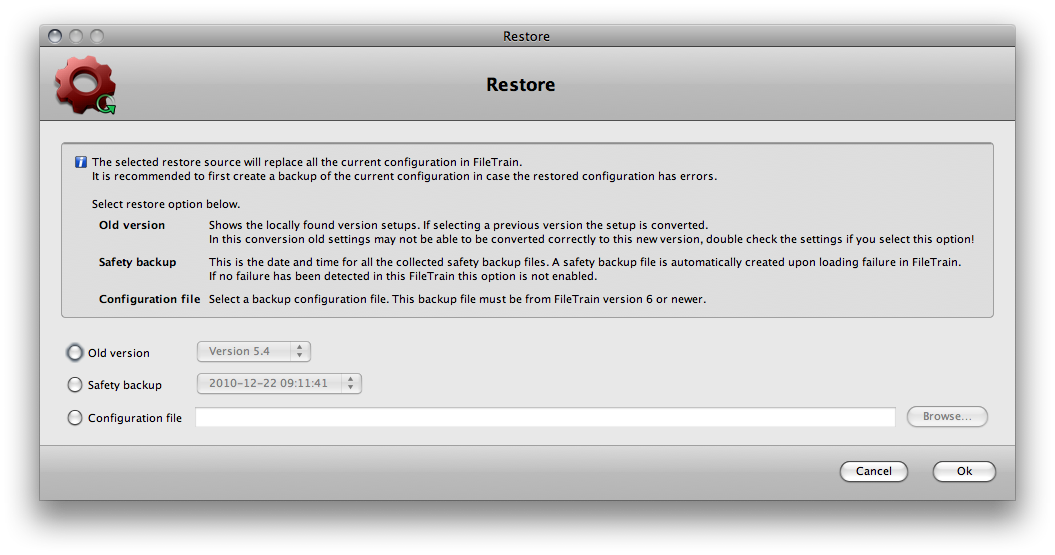
The restore dialog shows different restore options.
Restore setup in FileTrainWhen you use the restore button the restore window will show three options. If old preferences are found on the local machine you will see the list of versions available. If there are any safety backups they will be available in the safety backup part and you may also select an individual backup file (created by the backup option).
Important when getting old version settings
If you restore setup from a previous version of FileTrain it is very important to overlook the setup after the restore is done. Older versions of FileTrain may be more or less incompatible with the current version of FileTrain. Therefor it is important that you manually look through the setup after such a restore to make sure that the settings are correct.
Version backup
From FileTrain version 6.4 old version setups can manually be found in the subfolder -versionBackup found in the general FileTrain preferences folder. These backup files are created automatically when you install a newer version of FileTrain. When you start the new version, FileTrain will automatically detect that your old setup is from another version and put this file in the backup.
If you for some reason needs to re-install your fileTrain to an earlier version the preferences may not be able to be read if you have run a newer version of FileTrain. In this case you can restore
3.2 Stations
In the stations configuration you may create new, edit or delete existing stations.
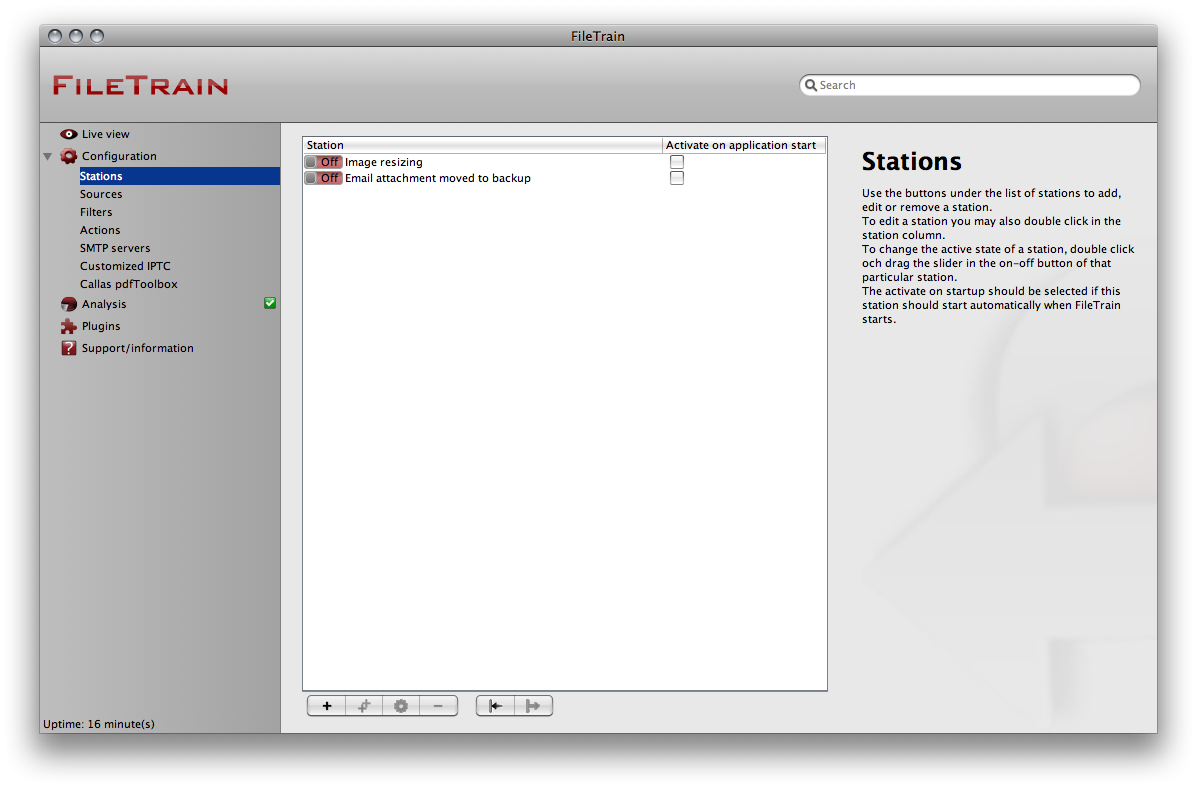
In the stations configuration you may create new, edit or delete existing stations.
Station configurationWhen editing a station the station setup window is shown. The setup of the station is explained in detail in the section 2.4 How to setup a workflow.
The stations have a little on/off slider attached next to their names. With this slider you control the current active state for the station. If the station is set to automatically start on startup the station will be active when FileTrain starts.
3.3 Sources
A source is a location where FileTrain will search for objects. The most common source is a folder on the local or remote network drive. Different sources may have different settings. FileTrain has four built-in sources, Email, Folder, FTP folder and Timer.
Sources may be developed as plugins to FileTrain. This enables other advanced sources such as different database sources, web loading etc. There are examples of very complex plugins developed for FileTrain where filtering and actions are included within the source which is working completely on it's own.
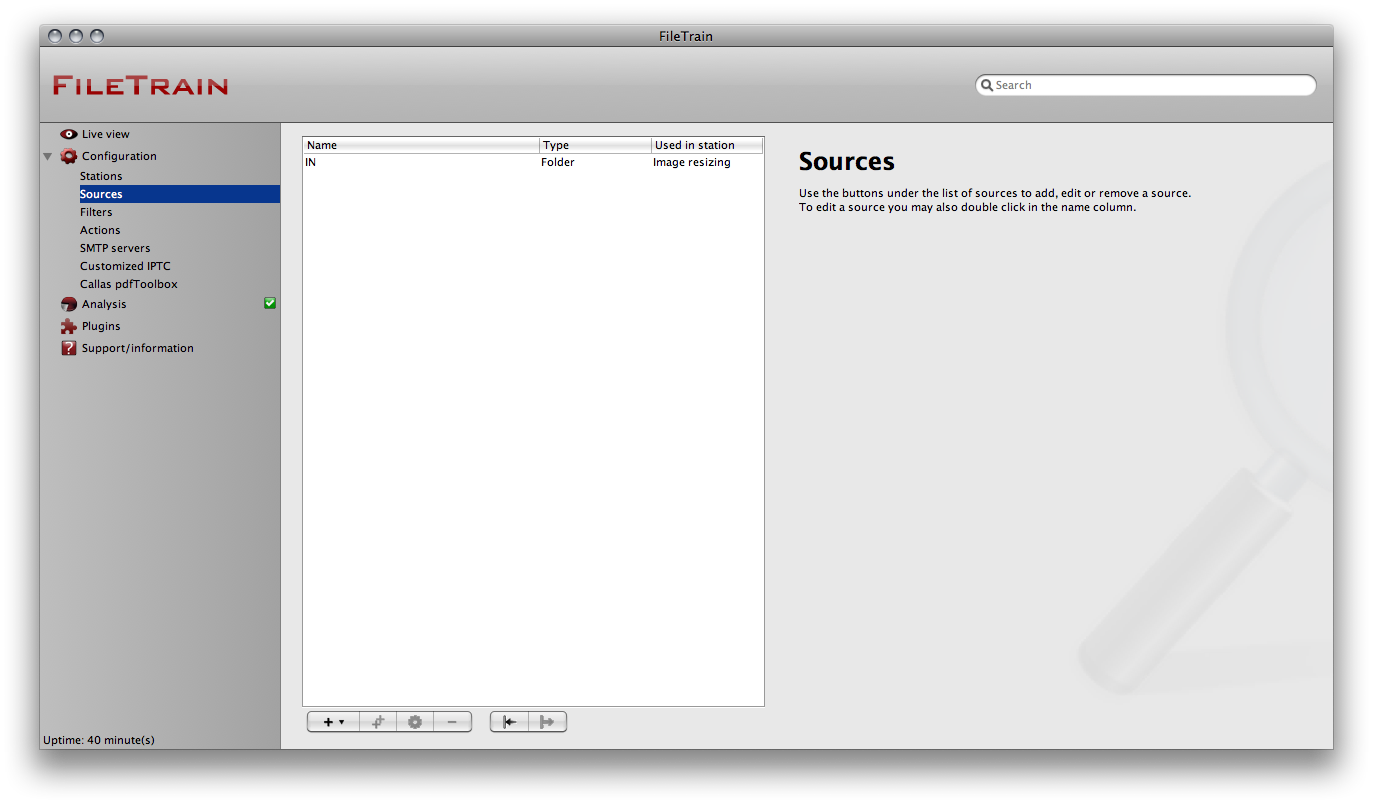
The main source configuration view.
Source configurationIn the source configuration you may see in which station/stations the source is used. You may therefor quickly spot and delete sources that are not in use in any station. Most sources will have a setup for how often they will scan their source. This source schedule setup is described below.
Source schedule
A common setting in the sources are the scan interval which has soem advanced features. This schedule setup is used to decide when the source should make a scan (e.g. a folder source looks for new files in it's source folder).
The schedule is divided into two parts, one standard schedule setup and one additional setup.
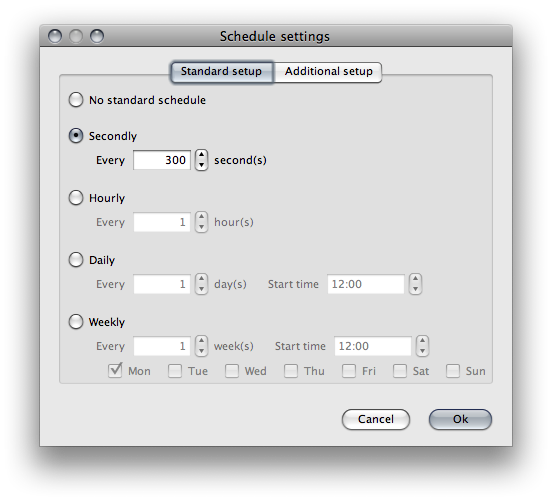
The standard schedule setup view.
Standard schedule setupThere is an option in the standard schedule view to not use a standard schedule. If this option is selected only additional schedule will be invoked. The other options for the standard schedule are secondly, hourly, daily and weekly. Select the appropriate option for the source.
Secondly and hourly will scan every X second or hour.
The daily option has a time of the day when the scan will be done and an option to do this every day or every X day. If you for example use every 3 day(s) and the station starts at a monday, the next scan will be done on thursday (3 days ahead of monday).
The weekly option let you set a time of the day when to invoke the source and select which days of the week that should be included. Use this option if you for example want the source to be invoked mon-fri but not sat and sun.

The additional schedule setup view.
Additional schedule setupThe additional schedule is a list of additions. The items in the additional setup will work complimentary to the standard setup.
When adding a new additional schedule part you first have to decide when this part should be active. You can add several 'when' settings and the schedule part will only be invoked when all the 'when' setup is ok.
Below the when setup you select how often the schedule will be invoked during this when period.
Important note
If you use a setup which is impossible to achieve the source will not work at all
Combined setup for 'when'
If you for example want the additional schedule part to take place at monday and wednesday between 1 pm and 3 pm you select hour of day and put 13:00 and 15:00 in the from and to fields, then you add a new row with the add button on the right and you select day of week and select monday and wednesday.
Email source
The email source is a special source that is able to scan an email server account and handle the emails on this account. The protocols supported are POP3 and IMAP. See table below for more information about the settings.
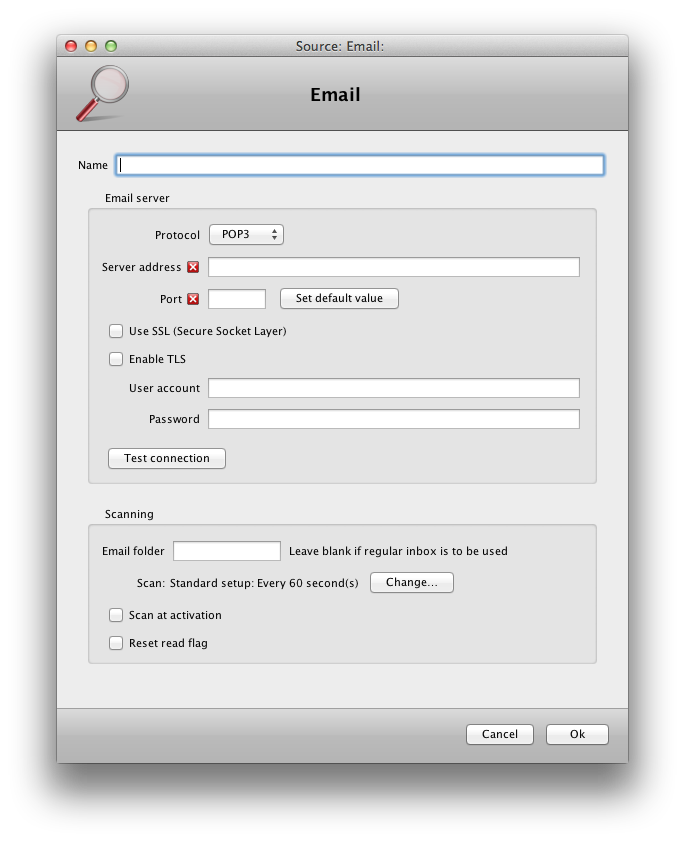
The email source settings.
Email source preferences
Settings for email source
| Setting |
Description |
| Name |
The name for this component. This name is used throughout the rest of the settings in FileTrain and is acting as an identifier for the component. |
| Protocol |
Selector for the protocol to use, either POP3 or IMAP. |
| Server address |
The email server name, either as IP number or DNS name, e.g. 192.168.40.1 or mail.yourserver.com. |
| Port |
The email server port. If the default port should be used, click the button 'Set default value' after first selecting the correct protocol. |
| Use SSL |
If this check box is selected FileTrain will use the secure socket layer whilst communicating with the email server. |
| Enable TLS |
Enabling TLS communication with the email server |
| User account |
The user login for the email account which should be monitored. |
| Password |
The password for the user account above. |
| Email folder |
Use this field to enter the name of the email folder holding the emails. Leave this field blank if you are using the regular inbox folder for the email account. |
| Scan |
This describes how often the source will be scanned. To change the setting, click the 'Change' button. More information about the scan setup is seen in the source schedule section. |
| Scan at activation |
If this check box is selected this source will do an initial scan when the source is started. |
| Reset read flag |
If this check box is selected the email's read flag on the email server will be reset after FileTrain has handled them. |
Folder source
A folder source is scanning a folder on a local or remote network drive. The monitored folder is accessed through the regular file system. See table below for more information about the individual settings.
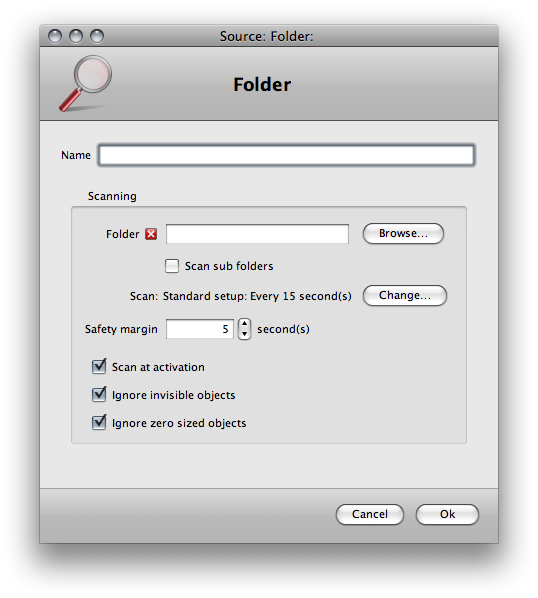
The folder source settings.
Folder source preferences
Settings for folder source
| Setting |
Description |
| Name |
The name for this component. This name is used throughout the rest of the settings in FileTrain and is acting as an identifier for the component. |
| Folder |
The folder to monitor. Click the 'Browse...' button to change the location. |
| Scan sub folders |
If this check box is selected the sub folders in the folder will also be monitored and handled in the same way as the root folder. If the folder structure for found objects should be kept there is an option in relevant actions to keep the folder structure. |
| Scan |
This describes how often the source will be scanned. To change the setting, click the 'Change' button. More information about the scan setup is seen in the source schedule section. |
| Safety margin |
The safety margin is an interval during which objects need to stay intact. If an object is not changing during a safety interval it is considered to be ready for handling by FileTrain.
By 'changing' FileTrain will consider the file size for regular files and the total file count and file size if the object is a folder. |
| Scan at activation |
If this check box is selected the source will do an initial scan when the source is started. |
| Ignore invisible objects |
If this check box is selected FileTrain will ignore objects that are considered to be invisible by the operating system. |
| Ignore zero sized objects |
If this check box is selected FileTrain will ignore files that are zero (0) byte in size and empty folders.
|
Multi Folder source
The multi folder source is a more effecient source to use if many different source folders should be used in the same station.
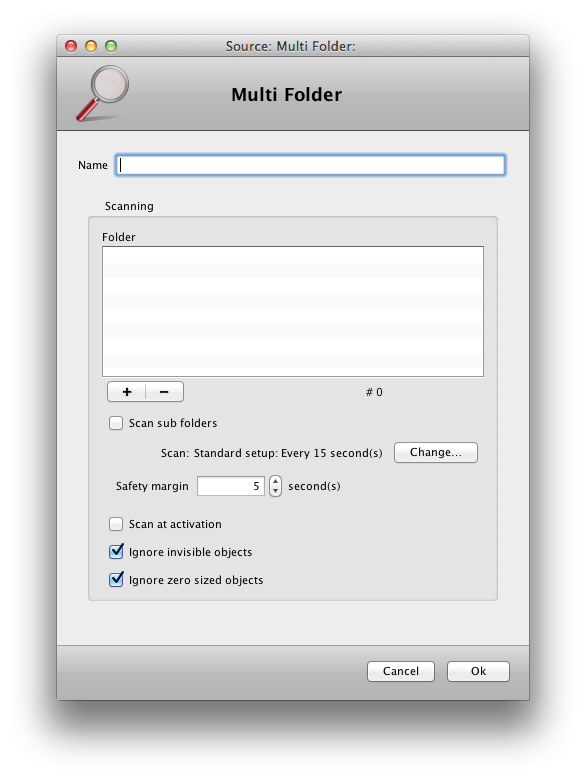
The Multi Folder source settings.
Multi Folder source preferences
Settings for Multi Folder source
| Setting |
Description |
| Name |
The name for this component. This name is used throughout the rest of the settings in FileTrain and is acting as an identifier for the component. |
| Folder |
The list of folders to monitor. Click the '+' and '-' buttons to add and remove folders. You may also drag and drop folders from the file system directly on the list to add folders. |
| Scan sub folders |
If this check box is selected the sub folders in the folder will also be monitored and handled in the same way as the root folder. If the folder structure for found objects should be kept there is an option in relevant actions to keep the folder structure. |
| Scan |
This describes how often the source will be scanned. To change the setting, click the 'Change' button. More information about the scan setup is seen in the source schedule section. |
| Safety margin |
The safety margin is an interval during which objects need to stay intact. If an object is not changing during a safety interval it is considered to be ready for handling by FileTrain.
By 'changing' FileTrain will consider the file size for regular files and the total file count and file size if the object is a folder. |
| Scan at activation |
If this check box is selected the source will do an initial scan when the source is started. |
| Ignore invisible objects |
If this check box is selected FileTrain will ignore objects that are considered to be invisible by the operating system. |
| Ignore zero sized objects |
If this check box is selected FileTrain will ignore files that are zero (0) byte in size and empty folders.
|
FTP source
FileTrain may scan a remote folder located on a FTP server using the File Transfer Protocol. See table below or more information about the individual settings.
When objects are to be handled from the FTP server the objects are lazily downloaded to a temporary folder before actions are invoked on them. This makes FileTrain very effecient if many actions are to be invoked upon an object. The lazily download means that the objects are not downloaded unless they are really needed to be.
If the local temporary object is removed during action handling (for example if a move action is invoked) the server object will be deleted by FileTrain after handling is done.
 FTP source preferences
FTP source preferences
Settings for FTP source
| Setting |
Description |
| Name |
The name for this component. This name is used throughout the rest of the settings in FileTrain and is acting as an identifier for the component. |
Type |
The type settings enables you to select what type of FTP connection to use:
FTP: A regular FTP connection, this is the most commonly used connection.
SFTP: Use this if the FTP server is supporting FTP over SSH.
FTPS: Use this if the FTP server is supporting FTP over SSL.
Depending on the type selected various other selections are available such as passive FTP transfer etc. |
| Encoding |
The default encoding is UTF8 when transfering data to and from the FTP server. If your FTP server is using another set of encoding you may specify that encoding here. |
| Server address |
The FTP server name, either as IP number or DNS name, e.g. 192.168.40.2 or ftp.yourserver.com. |
| Port |
The FTP server port. The default FTP port is 21. |
| User account |
The user login for the account which should be monitored. |
| Password |
The password for the user account above. |
| Folder |
The folder to monitor. This is the path to the folder seen from the login location on the FTP server. Note that different user account may have different root folders on the FTP server. The folder specified in this field is the path from the root folder when logging in with the user account above.
Be aware that a forward slash (/) may have to precede the folder path (depending on the FTP server). |
| Scan sub folders |
If this check box is selected the sub folders in the folder will also be monitored and handled in the same way as the root folder. If the folder structure for found objects should be kept there is an option in relevant actions to keep the folder structure. |
| Scan |
This describes how often the source will be scanned. To change the setting, click the 'Change' button. More information about the scan setup is seen in the source schedule section. |
| Safety margin |
The safety margin is an interval during which objects need to stay intact. If an object is not changing during a safety interval it is considered to be ready for handling by FileTrain. |
| Scan at activation |
If this check box is selected the source will do an initial scan when the source is started. |
| Ignore invisible objects |
If this check box is selected FileTrain will ignore objects that are considered to be invisible by the system. |
| Ignore zero sized objects |
If this check box is selected FileTrain will ignore files that are zero (0) byte in size and empty folders.
|
Timer source
The timer source is a special source which will not scan any server or folder but only work similar to an alarm clock. When the 'alarm' is due this source will tell the station to execute. The station must be setup with the special timer filter in order to actually do anything. The actions contained in the timer filter will be executed.
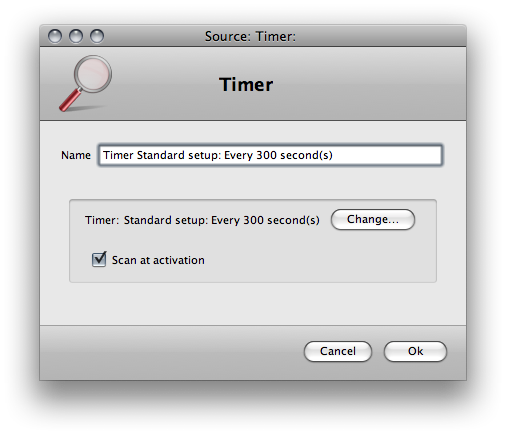
The timer source settings.
Timer source preferences
Settings for timer source
| Setting |
Description |
| Name |
The name for this component. This name is used throughout the rest of the settings in FileTrain and is acting as an identifier for the component. |
| Timer |
This describes how often the source will 'set off'. To change the setting, click the 'Change' button. More information about this setup is seen in the source schedule section. |
| Scan at activation |
If this check box is selected the source will 'set off' initially when the source is started. |
3.4 Filters
Filters are filtering the objects detected in the sources. This enables advanced workflow where different kind of objects may be routed to different workflows.
There are five default filter types, email, file, folder and the more special misc filter and timer filter. When FileTrain is started without any filters present the user will be asked if default filters should be created. These default filters are some commonly used filters and their names will be preceded by three asterisks (***). The default filters are editable and may be changed by the user.
All filters have a name. This name is used throughout the rest of the settings in FileTrain and is acting as an identifier for the component. Furthermore the filters have a set of restrictions. To add a new restriction the button with a plus is clicked, to remove a restriction the button with a minus next to that restriction is clicked. Some restrictions have a check box called 'invert'. If this invert check box is selected the restriction settings for that particular row will be inverted.
The invert check box
Using a file filter with the name restriction
*.pdf
will let any file with the file extension pdf pass the filter.
If the invert check box is selected only files that does NOT have the file extension pdf will pass.
Below the restriction set there is a selection whether one of the restrictions is sufficient or if all the restrictions must be met.
Email filter
The email filter is a special filter being able to filter emails on a remote email server. An email source must have an email filter to be able to handle the email itself. If attachments of the email is to be handled a regular file filer should be used. Even if a file filter is used the macros to get certain email values such as subject or sender are availlable when actions handle the attachment file. If you use the email filter the actions for this filter will only have the email itself to work with, not the attachment files.
Attachments
To filter on individual attachments, use a file filter instead.
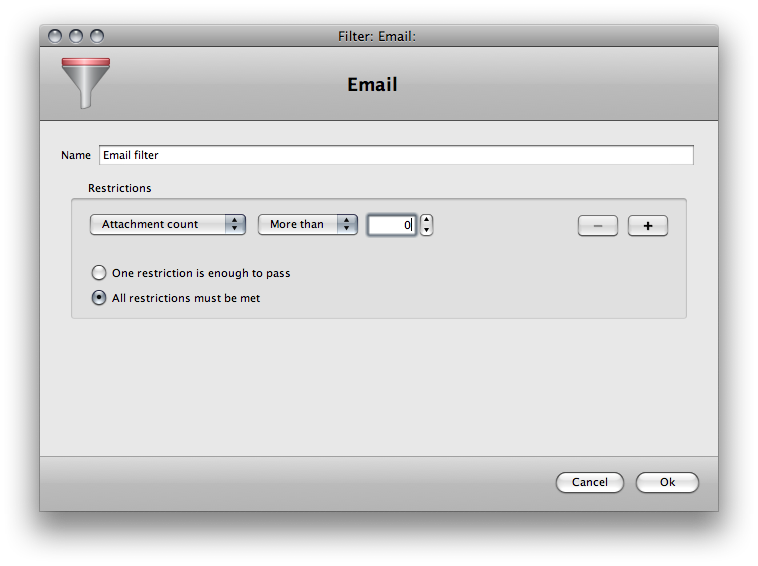
The email filter settings.
Email filter preferences
Restrictions for email filter
| Restriction |
Description |
| Attachment name |
This will filter on any of the attachment's name. Asterisk (*) may be used as a wild card meaning any character (0, 1 or more characters). Question mark (?) may be used as a wild card where there must be a character but that character may be any character.
If different names are wanted you separate them with commas. For example, if files that ends with '.eps' and files that ends with '.ps' should be filtered you enter '*.eps, *.ps' in the file name field.
Note that it is enough that one attachment is passing this filter for the email to be handled. Also note that if the attachment itself is wanted to be handled, use a regular file filter instead. |
| Attachment count |
This will compare the email's attachment count and if equal, less than or greater than the specified number the email will be handled. |
| Email sender |
This will compare the email sender with the text entered. The same rules with asterisk, question marks and commas applies as for attachment name and email body. |
| Email body |
This will compare the email body with the text entered. The same rules with asterisk, question marks and commas applies as for attachment name and email sender. |
| Email sent |
This is the time when the email was sent. If the send time compared to current time is larger than the specified time, the email is handled. |
| Time from discovery |
This is the time from the moment FileTrain detects the object. When the specified time has elapsed the object is handled. |
| Bucket |
This filter will check a specific bucket key. The filtering may check if the bucket value is equal to a certain value or if the bucket value contains a text or if the bucket value at all exists.
You must select if the bucket key that is checked is from a station bucket or object bucket, read more about the different buckets in chapter 2. |
| File exists |
This filter may check if an external file with the path specified exists or not. |
File filter
The file filter is filtering regular files as well as FTP files and attachments in emails.

The file filter settings.
File filter preferences
Restrictions for file filter
| Restriction |
Description |
| File name |
This will filter on the file name. Asterisk (*) may be used as a wild card meaning any character (0, 1 or more characters). Question mark (?) may be used as a wild card where there must be a character but that character may be any character.
If different names are wanted you separate them with commas.
Example, if files that ends with '.eps' and files that ends with '.ps' should be filtered you enter '*.eps, *.ps' in the file name field. |
| Size |
This denotes the file size. You may select that the file size should be equal, less than or bigger than a certain byte count. |
| Modification time |
This is the file modification time. If the modification time compared to current time is larger than the specified time, the file is handled. |
| Time from discovery |
This is the time from the moment FileTrain detects the file. When the specified time has elapsed the file is handled. |
| IPTC |
This feature is reading the actual IPTC information in the file (works only with jpg and tiff files).
Select the IPTC field in the popup and select one of the following;
Equals: The IPTC field value should be exact as specified.
Contains: The IPTC field should contain the value specified.
Has value: The IPTC field should contain something. |
| PDF format |
This feature is only working on PDF files. You may choose to check any of the following boxes; Media box, Crop box, Bleed box, Trim box or Art box and you may check either width or height or both whether they are less than, bigger than or equals a certain number in millimeters. |
| PDF version |
This feature is only working on PDF files. Specify the version number, e.g. 1.3 and select whether the version on the files has to be this version, must be less than or greater than this version. |
| XMP |
This will filter the file on the XMP content. This is only applicable to JPG, PDF and TIFF files.
Select the XMP property in the popup and select one of the following;
Equals: The XMP value should be exact as specified.
Contains: The XMP value should contain the value specified.
Has value: The XMP value should be present in the file. |
| MP3 album |
This will look at the ID3 information of the file and filter on the album tag. (works only with MP3 files).
The same special characters as for the file name restriction can be used. |
| MP3 artist |
This will look at the ID3 information of the file and filter on the artist tag. (works only with MP3 files).
The same special characters as for the file name restriction can be used. |
| MP3 comment |
This will look at the ID3 information of the file and filter on the comment tag. (works only with MP3 files).
The same special characters as for the file name restriction can be used. |
| MP3 genre |
This will look at the ID3 information of the file and filter on the genre tag. (works only with MP3 files).
The same special characters as for the file name restriction can be used. |
| MP3 title |
This will look at the ID3 information of the file and filter on the title tag. (works only with MP3 files).
The same special characters as for the file name restriction can be used. |
| MP3 track |
This will look at the ID3 information of the file and filter on the track tag. (works only with MP3 files).
Put the number in the input area and select one of the following;
Equals: The ID3 value should be exact as specified.
Less than: The ID3 value should should be less than the value specified.
More than: The ID3 value should should be morethan the value specified. |
| MP3 track count |
This will look at the ID3 information of the file and filter on the track count tag. (works only with MP3 files).
Put the number in the input area and select one of the following;
Equals: The ID3 value should be exact as specified.
Less than: The ID3 value should should be less than the value specified.
More than: The ID3 value should should be morethan the value specified. |
| MP3 year |
This will look at the ID3 information of the file and filter on the year tag. (works only with MP3 files).
Put the year in the input area and select one of the following;
Equals: The ID3 value should be exact as specified.
Less than: The ID3 value should should be less than the value specified.
More than: The ID3 value should should be morethan the value specified. |
| Color space |
This restriction will pass files that has the specified color space. |
| Image resolution |
Checks the x and/or the y resolution in DPI. |
| Image dimensions |
Filter on the actual dimensions of the image. |
| Bucket |
This filter will check a specific bucket key. The filtering may check if the bucket value is equal to a certain value or if the bucket value contains a text or if the bucket value at all exists.
You must select if the bucket key that is checked is from a station bucket or object bucket, read more about the different buckets in chapter 2. |
| File exists |
This filter may check if an external file with the path specified exists or not. |
Folder filter
The folder filter handles folders. Please note that some of the restrictions may not work for remotely located folders. See table 3.3-5 for more information about the restrictions for this filter.

The folder filter settings.
Folder filter preferences.
Restrictions for folder filter
| Restriction |
Description |
| Folder name |
This will filter on the folder name. Asterisk (*) may be used as a wild card meaning any character (0, 1 or more characters). Question mark (?) may be used as a wild card where there must be a character but that character may be any character.
If different names are wanted you separate them with commas. |
| Size |
This denotes the number of items within the folder (both files and folders). You may select that the count should be equal, less than or bigger than a certain number. |
| Modification time |
This is the folder modification time. If the modification time compared to current time is larger than the specified time, the folder is handled. |
| Time from discovery |
This is the time from the moment FileTrain detects the folder. When the specified time has elapsed the folder is handled. |
| Bucket |
This filter will check a specific bucket key. The filtering may check if the bucket value is equal to a certain value or if the bucket value contains a text or if the bucket value at all exists.
You must select if the bucket key that is checked is from a station bucket or object bucket, read more about the different buckets in chapter 2. |
| File exists |
This filter may check if an external file with the path specified exists or not. |
Misc filter
The misc filter is a special filter which may be used in various situations. This filter have the special restriction 'pass all' which will allow anything through the filter.
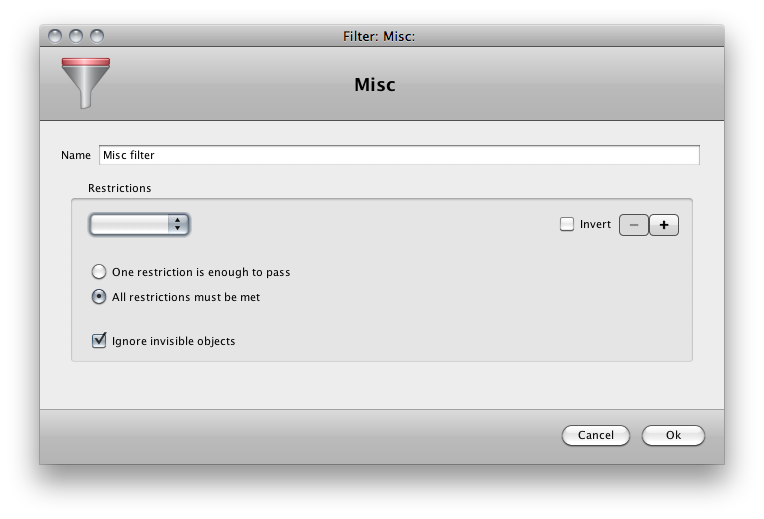
The misc filter settings.
Misc filter preferences.
Restrictions for misc filter
| Restriction |
Description |
| Allow all |
Lets all objects through. |
| Bucket |
This filter will check a specific bucket key. The filtering may check if the bucket value is equal to a certain value or if the bucket value contains a text or if the bucket value at all exists.
You must select if the bucket key that is checked is from a station bucket or object bucket, read more about the different buckets in chapter 2. |
| File exists |
This filter may check if an external file with the path specified exists or not. |
Timer filter
Special filter used with timer sources.

The timer filter settings.
Timer filter preferences.
Restrictions for timer filter
| Restriction |
Description |
| Allow all |
Lets all objects through. |
| Bucket |
This filter will check a specific bucket key. The filtering may check if the bucket value is equal to a certain value or if the bucket value contains a text or if the bucket value at all exists.
You must select if the bucket key that is checked is from a station bucket or object bucket, read more about the different buckets in chapter 2. |
| File exists |
This filter may check if an external file with the path specified exists or not. |
3.5 Actions
Objects that have been filtered might be handled in different ways. This is where the actions are used. An action is a 'handling' invoked on an object. This handling may affect the object (for example moving the object) or it may just use the object as reference for doing some other action (for example sending an email).
FileTrain has some default actions. However actions may be developed as plugins to FileTrain. Therefore very advanced actions may be invoked on an object. This may involve advanced merging of documents, updating of databases or other repositories or other integrations with existing systems and/or applications.
Each built-in action is described in more detail below where you will find information about what the action is handling. Some actions may add values in the station bucket, this information is also found in each description below.
Email handling
If an email is being filtered in the special email filter (see above) the email itself is treated but not the individual attachments.
If on the other hand an email is filtered in a file filter the attachments will be treated individually.
AdPoint action
Handles
Email
Files
Folders
Integration with the AdPoint web interface from Lineup.
This action makes a call to the AdPoint web interface and the result XML (if any) is stored in a bucket key.
Table Bucket fields affected by the AdPoint action
| Bucket key |
Value |
<name of action>.resultXML |
The result XML from the AdPoint call. |
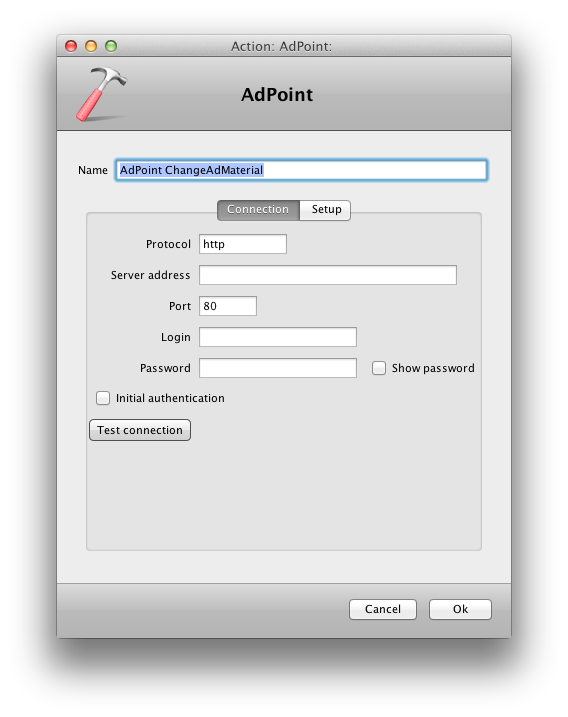
The settings for the applescript action.
AdPoint action preferences
Settings for the AdPoint action
| Setting |
Description |
| Name |
The name for this component. This name is used throughout the rest of the settings in FileTrain and is acting as an identifier for the component. |
| |
|
Apple script action
Handles
Email
Files
Folders
This action is only available on the Macintosh platform. This action will execute an applescript.
The object that caused this action to execute is not affected by this action unless the applescript itself is having an effect on the object.
Table 3.5-1 Bucket fields affected by the applescript action
| Bucket key |
Value |
Comment |
ScriptResult-<name of action>
|
If the script that is executed returns a value this value is stored in this bucket value.
|
The <name of action> is the name of the FTP action that is given in the preferences. If you for example has a FTP action that is named 'execute script' the file list will be found in the bucket with key 'ScriptResult-execute script'. |
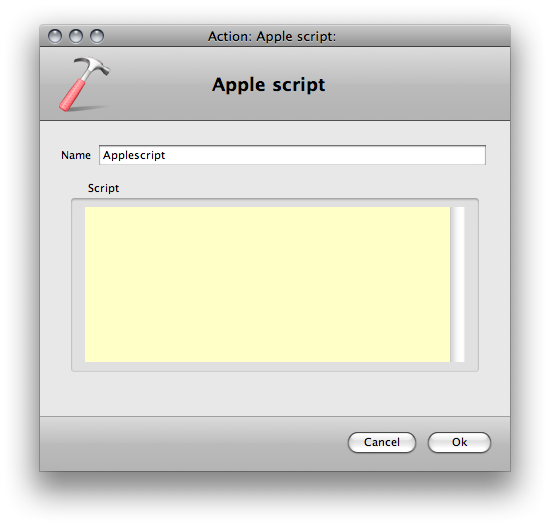
The settings for the applescript action.
Settings for the applescript action
| Setting |
Description |
| Name |
The name for this component. This name is used throughout the rest of the settings in FileTrain and is acting as an identifier for the component. |
| Script |
This is the sript to execute. |
Backup action
Handles
Email
Files
Folders
This is a special version of the copy action which is suitable when using the copying as a backup. The difference compared to a copy action is that the backup action will first see if the file exists in the backup location. If the file exists and is the same (same size and modification time) it will be ignored and not added again by the backup action. If the file exists but is not the same the duplication handling will be used to determine what to do.

The settings for the backup action.
Settings for the backup action
| Setting |
Description |
| Name |
The name for this component. This name is used throughout the rest of the settings in FileTrain and is acting as an identifier for the component. |
| Root destination |
This is the root folder where the action will put the object. If the routing field (see below) is empty the object will be placed in the root destination, otherwise in a sub location described by the routing field. The location entered in this field must exist, see note for the routing field. |
| Routing |
Use this field to enter a sub location to the root destination. This field is a macro field and may contain macros. If you for example enter '%D%' in the routing field the final destination folder will be a sub folder with the current date in the root destination.
Note
The root destination must exist for the action to be executed correctly. The final destination folder created with the routing does not need to exists, it will be created if it is not present.
|
| Name change |
If this field is having a value the object will get this name at the final location. This can for example be used to add a special prefix on the object. If we need to add the prefix 'A-' on the object we will put 'A-%F%%E%' in the name change field (see the section about macros for more information). |
| Keep folder structure |
The folder structure is the sub folder structure seen from the source main folder where it applies.
Example: A folder source is set to watch folder A and also selected to search subfolders. The pdf file file.pdf is detected in the folder A/B/file.pdf. If the keep folder structure is selected the result file will be placed in the sub folder B also in the end location. |
| Overwrite if duplicate |
This option will first delete the duplicate, then replace it with the new one from this action.
See information of the special macro %DUPLICATE_FILE_EXTRA[...]% for more options regarding duplicate files. |
Bucket action
Handles
Email
Files
Folders
This action may be used to set one or more values in the current station's bucket. This may be very handy if you for example use the station for email handling and have a filter to handle only certain type of files but later would like to move all emails where such files have been found. You may in that case set a certain bucket value after handling the file. A latter email filter may then use this bucket value to filter only those emails that contained this type of file to handle the email.

The settings for the bucket action.
Settings for the bucket action
| Setting |
Description |
| Name |
The name for this component. This name is used throughout the rest of the settings in FileTrain and is acting as an identifier for the component. |
| Object bucket or station bucket |
Select whether this action will affect the station bucket or the object bucket.
Read more about the different buckets in chapter 2. |
| Values |
Bucket setup is one or more bucket keys and values. The key is the bucket key and the value its value. |
Callas pdfToolbox action
Handles
Email
Files
Folders
This action will use Callas pdfToolbox to perform an action or profile. To be able to use this action the Callas pdfToolbox configuration setup needs to be properly set. When the Callas pdfToolbox folder is set all the local profiles are loaded and analyzed in FileTrain. This loading may take a couple of minutes. Once the loading has finished the profiles may be used.
For more information regarding the setup in profiles or actions, see the Callas pdfToolbox documentation found at www.callassoftware.com.
To perform a profile upon a file the profile radio button should be checked and the wanted profile may be selected. All the profiles have the same setup as described below.
One or more reports may be created in a profile.

The general settings for a Callas pdfToolbox profile.
General setup for a pdfToolbox profile |

The reports settings for a Callas pdfToolbox profile.
Reports setup for a pdfToolbox profile |
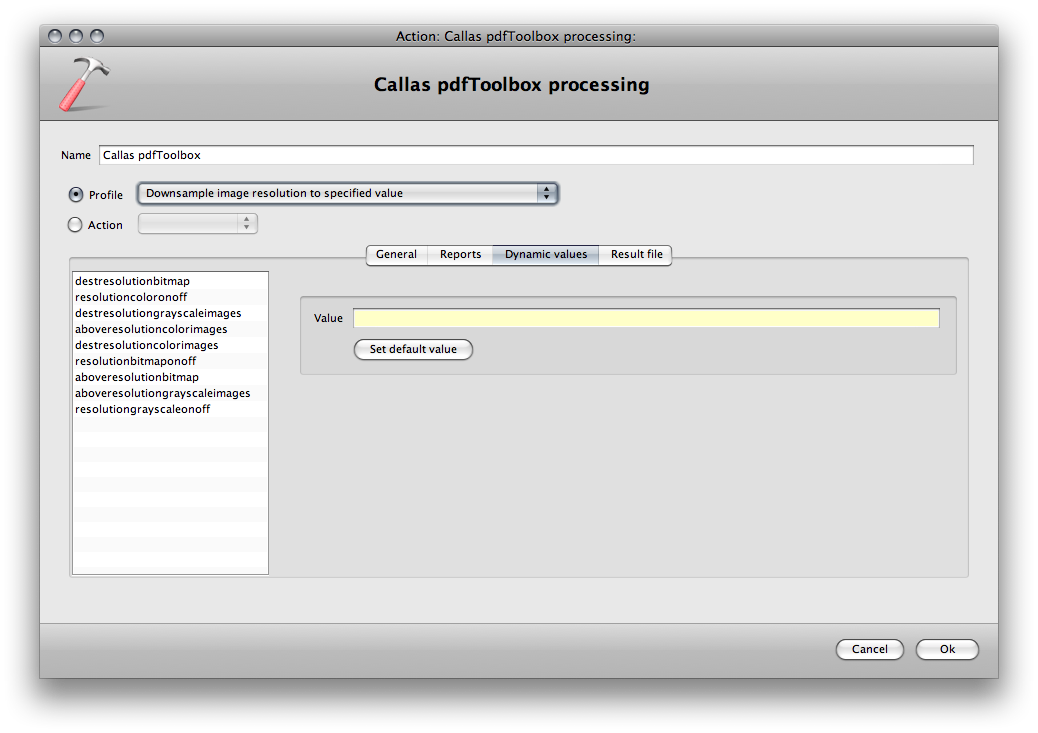
The dynamic variables settings for a Callas pdfToolbox profile.
Dynamic variable setup for a pdfToolbox profile |
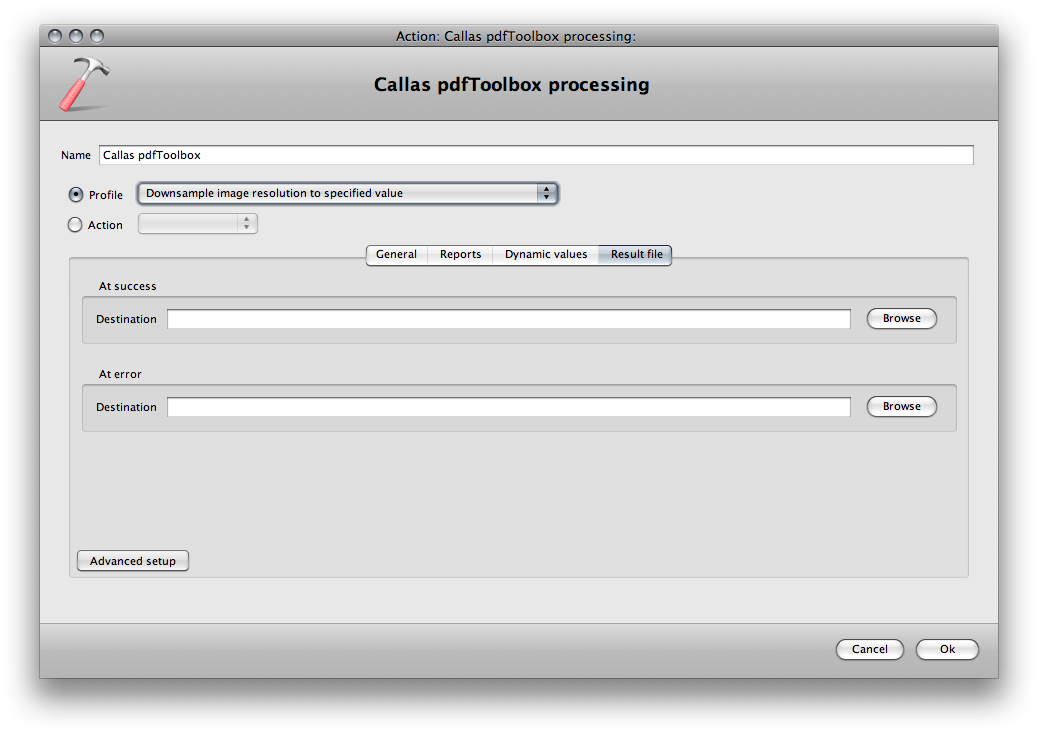
The simple result settings for a Callas pdfToolbox profile.
Simple result setup for a pdfToolbox profile |

The advanced result settings for a Callas pdfToolbox profile.
Advanced result setup for a pdfToolbox profile |
Settings for the pdfToolbox profiles
| General setup |
| Setting |
Description |
| Limit to page range |
If the profile only should handle a certain page range this range should be entered here. |
| Apply fixes |
If this option is not selected the fixups of the profiles will not be performed. |
| Reports setup |
| Setting |
Description |
| Report language |
The wanted localization in the reports. |
| Report trigger |
This selection determins when the current report should be created. |
| Report type |
The type of report that should be created. |
| Include overview |
If this option is selected the report will contain an overview. This option is only affecting PDF type reports. |
| Low resolution PDF |
Select this option if the report should be created as a low resolution PDF. |
| Root destination |
This is the root folder where the report will be saved. If the routing field (see below) is empty the report will be placed in the root destination, otherwise in a sub location described by the routing field. The location entered in this field must exist, see note for the routing field. |
| Routing |
Use this field to enter a sub location to the root destination. This field is a macro field and may contain macros. If you for example enter '%D%' in the routing field the final destination folder will be a sub folder with the current date in the root destination.
Note
The root destination must exist for the action to be executed correctly. The final destination folder created with the routing does not need to exists, it will be created if it is not present.
|
| File name |
The file name for this report. |
| Overwrite if duplicate |
This option will first delete the duplicate, then replace it with the new one from this action.
See information of the special macro %DUPLICATE_FILE_EXTRA[...]% for more options regarding duplicate files. |
Dynamic value setup
If the profile that is selected have dynamic variables these variables will be shown in the variable list. When a variable is selected the default value is first shown. This default value may be changed. To restore the variables value to the default, use the button under the value field. |
Result file setup
The result file setup has two views, one simple and one advanced. The simple setup contains the path to where a result file should be saved. There are two different paths depending on the outcome fo the profile, one for success and one for errors. The error path is used if an error hit is detected in the file while running the profile.
The advanced setup is used to set options for individual outcomes from the process. |
| Setting |
Description |
| Setup options |
If the currently selected outcome should be linked to the properties from another outcome, select what outcome to be linked to. |
| Root destination |
This is the root folder where the result will be saved. If the routing field (see below) is empty the file will be placed in the root destination, otherwise in a sub location described by the routing field. The location entered in this field must exist, see note for the routing field. |
| Routing |
Use this field to enter a sub location to the root destination. This field is a macro field and may contain macros. If you for example enter '%D%' in the routing field the final destination folder will be a sub folder with the current date in the root destination.
Note
The root destination must exist for the action to be executed correctly. The final destination folder created with the routing does not need to exists, it will be created if it is not present.
|
| File name |
The file name for this file. |
| Overwrite if duplicate |
This option will first delete the duplicate, then replace it with the new one from this action.
See information of the special macro %DUPLICATE_FILE_EXTRA[...]% for more options regarding duplicate files. |
To execute a certain action the action radio button should be checked and the wanted action may be selected. Different actions have different setup as described below.
There are three actions implemented in this version of FileTrain:
- Create EPS
- Save as image
- Split PDF
All the actions have one setup tab in common, the result file setup. This setup describes where the output from the action should be placed. The individual action setup is described for each action below.
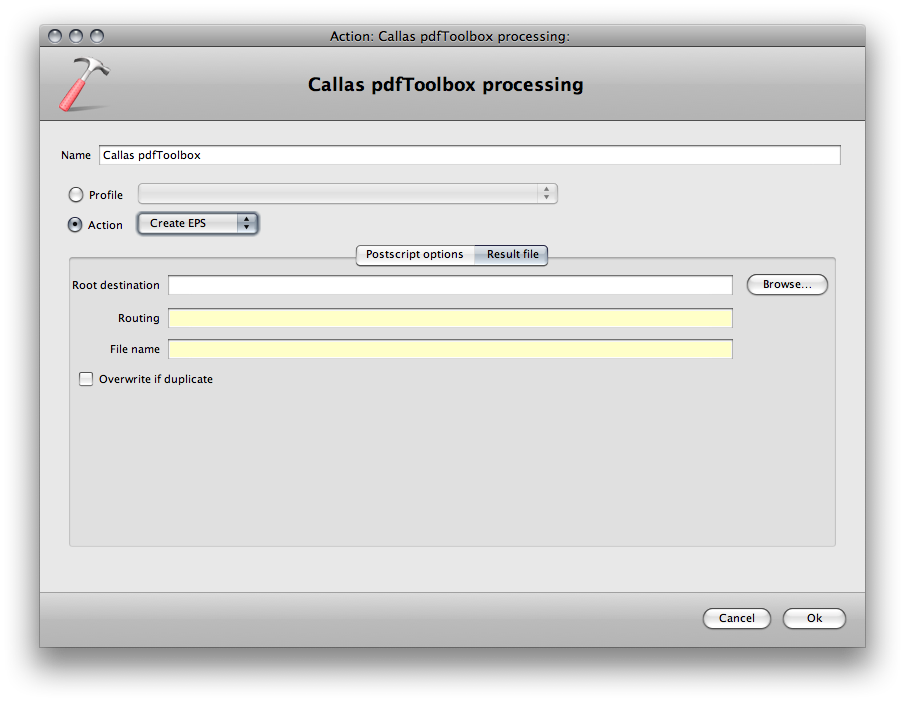
The result settings for a Callas pdfToolbox action.
Result file setup for a pdfToolbox action |
Settings for the pdfToolbox action result file
| Setting |
Description |
| Root destination |
This is the root folder where the result file(s) will be saved. If the routing field (see below) is empty the file(s) will be placed in the root destination, otherwise in a sub location described by the routing field. The location entered in this field must exist, see note for the routing field. |
| Routing |
Use this field to enter a sub location to the root destination. This field is a macro field and may contain macros. If you for example enter '%D%' in the routing field the final destination folder will be a sub folder with the current date in the root destination.
Note
The root destination must exist for the action to be executed correctly. The final destination folder created with the routing does not need to exists, it will be created if it is not present.
|
| File name |
The file name for the result file(s). |
| Overwrite if duplicate |
This option will first delete the duplicate, then replace it with the new one from this action.
See information of the special macro %DUPLICATE_FILE_EXTRA[...]% for more options regarding duplicate files. |
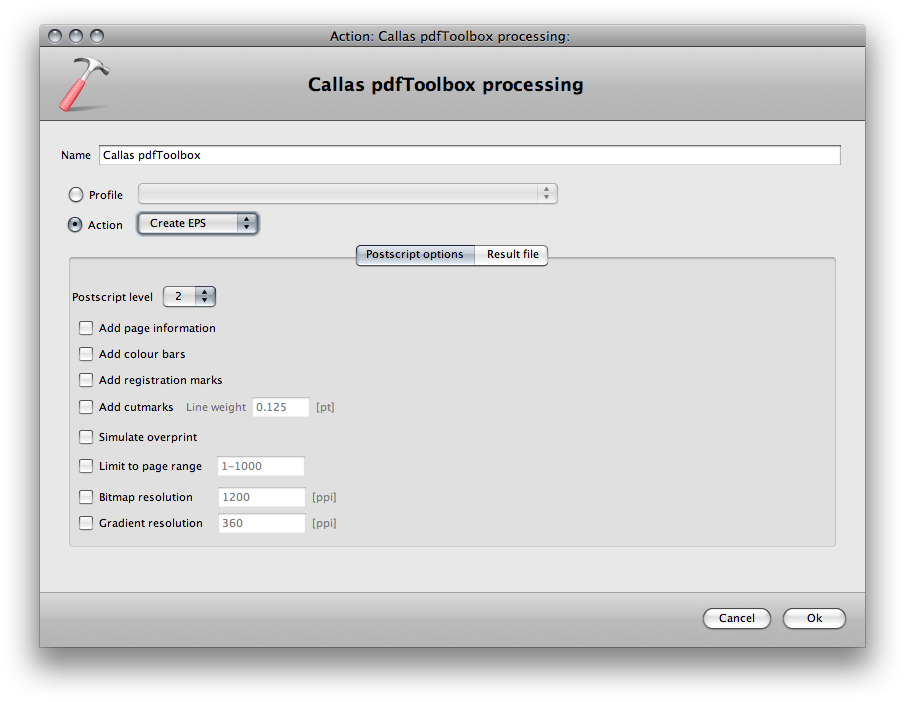
The general settings for the Callas pdfToolbox action that creates an EPS.
General setup for creating an EPS |
Settings for the create EPS action in pdfToolbox
| Setting |
Description |
| Postscript level |
The level of the postscript for the result file. |
| Add page information |
If selected the result file will contain page information. |
| Add colour bars |
If selected the result file will contain colour bars. |
| Add registration marks |
If selected the result file will contain registration marks. |
| Add cutmarks |
If selected the result file will contain cutmarks with the selected line width. |
| Simulate overprint |
If selected the result file will simulate overprint. |
| Limit to page range |
If the action only should handle a certain page range this range should be entered here. |
| Bitmap resolution |
The final resolution on bitmap objects. |
| Gradient resolution |
The final resolution on gradient objects. |
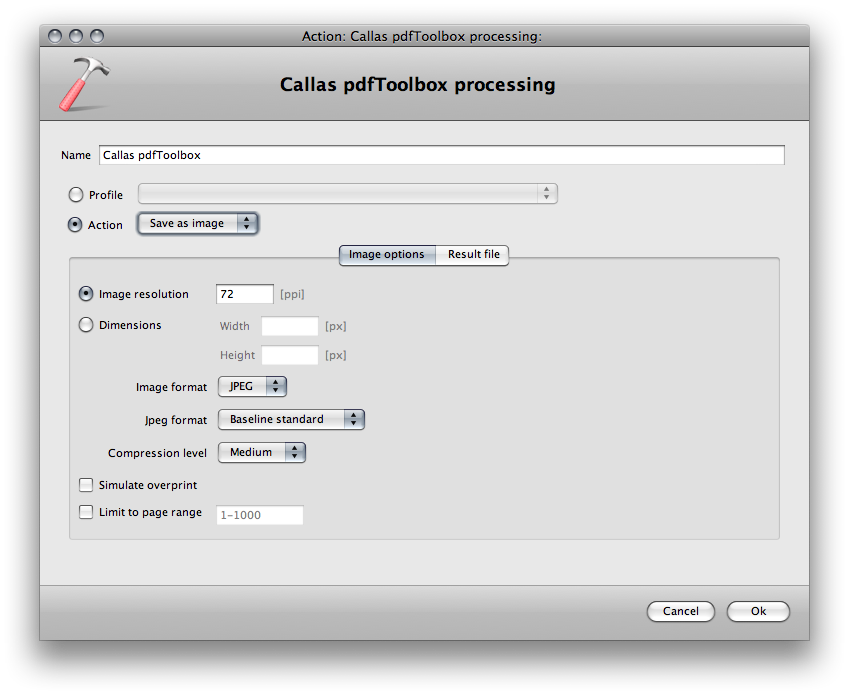
The general settings for the Callas pdfToolbox action that saves the file as an image.
General setup for saving an image from PDF |
Settings for the save as image action in pdfToolbox
| Setting |
Description |
| Image resolution |
If selected the final resolution can be set. |
| Dimensions |
If selected the dimension of the result image may be set. |
| Image format |
The image format of the result file. |
| Jpeg format |
If the image format is set to JPEG the format of the JPeg may be specified. |
| Compression level |
The compression level of the result file if the image format supports this. |
| Simulate overprint |
If selected the result file will simulate overprint. |
| Limit to page range |
If the action only should handle a certain page range this range should be entered here. |
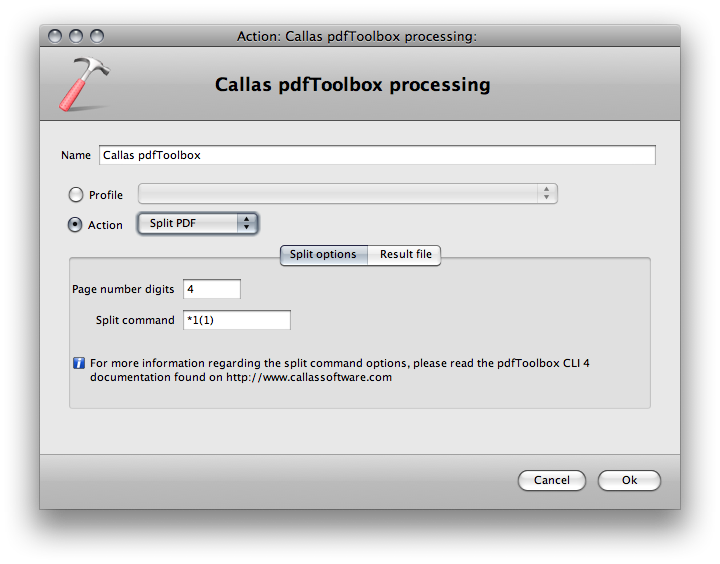
The general settings for the Callas pdfToolbox action that splits a PDF.
General setup for splitting a PDF |
Settings for the split PDF action in pdfToolbox
| Setting |
Description |
| Page number digits |
The number of characters to use in the result file name where the page number is located. |
| Split command |
This setup may be used to split a PDF in various ways. For more information see the Callas pdfToolbox CLI documentation found at www.callassoftware.com |
Cargo - add file to job action
Handles
Email
Files
Folders
This is a special action used in a system with Cargo.
The actions for Cargo requires a connection to a Cargo server. The connction is the full http path to the Cargo servlet. Normally this servlet is located in the cargo folder on the web server and the name is 'cargoServlet'. The server path is case sensitive.
When the cargo action is opened the action setup is trying to connect to the Cargo server to get necessary values from the server. If the user clicks the ok button before such a connection is made the settings may be damaged and the action may not work properly. Therefor it is important to always wait on the connection to finish. When the connection has finished the server tab is either showing a green check or a red cross to indicate successful or failed connection.
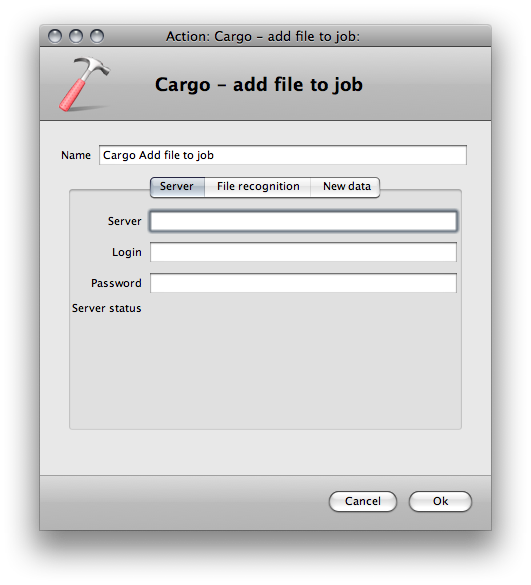
The settings for the Cargo add file action.
Cargo add file action preferences.
|
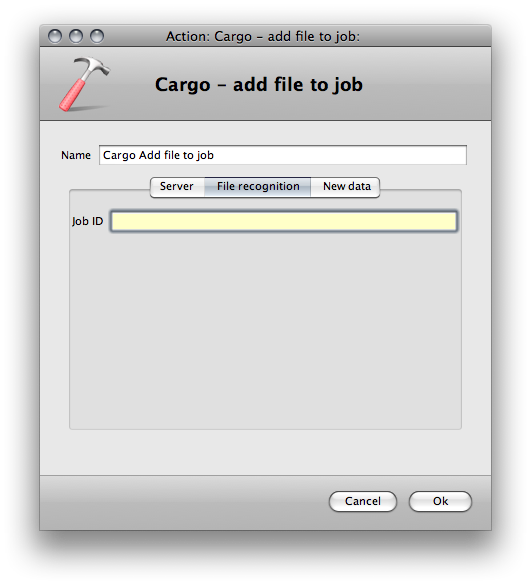
The settings for the Cargo add file action.
Cargo add file action preferences.
|

The settings for the Cargo add file action.
Cargo add file action preferences.
|
Settings for the Cargo add file action
| Setting |
Description |
| Name |
The name for this component. This name is used throughout the rest of the settings in FileTrain and is acting as an identifier for the component. |
| Server |
The full http path to the Cargo servlet. Normally this servlet is located in the cargo folder on the web server and the name is 'cargoServlet'. The server path is case sensitive.
Example) http://localhost:8080/cargo/cargoServlet |
| Login |
The Cargo user login to use when connecting. The rest of the setup may depend on the login in terms of available profiles, status values etc. |
| Password |
The password for the Cargo login. |
| Job ID |
This is the ID of the job to which the file that is currently handled will be added. |
| Status |
The new status for the file that is being added. If the selection 'do not change' is selected the status will be set by the profile to which the job belongs. |
| Location |
This is the location that will be saved in the Cargo server to be the location of the file. Normally this would be %FILE_PATH% but if the file is mvoed to another location after this action this other location may be used instead. |
| Ignore errors |
If this option is selected any error reported from the Cargo server will be ignored. |
| Job/File properties |
This is a set of job/file properties that will be set when adding the file. |
Cargo - attach file action
Handles
Email
Files
Folders
This is a special action used in a system with Cargo.
The actions for Cargo requires a connection to a Cargo server. The connction is the full http path to the Cargo servlet. Normally this servlet is located in the cargo folder on the web server and the name is 'cargoServlet'. The server path is case sensitive.
When the cargo action is opened the action setup is trying to connect to the Cargo server to get necessary values from the server. If the user clicks the ok button before such a connection is made the settings may be damaged and the action may not work properly. Therefor it is important to always wait on the connection to finish. When the connection has finished the server tab is either showing a green check or a red cross to indicate successful or failed connection.

The settings for the Cargo attach file action.
Cargo attach file action preferences.
|

The settings for the Cargo attach file action.
Cargo attach file action preferences.
|
Settings
for the Cargo attach file action
| Setting |
Description |
| Name |
The name for this component. This name is used throughout the rest of the settings in FileTrain and is acting as an identifier for the component. |
| Attachment path |
The file path to the attachment. Normally this would be %FILE_PATH%. |
| Attachment name |
The name of the attachment when seen in the Cargo Dispatch interface. |
| Server |
The full http path to the Cargo servlet. Normally this servlet is located in the cargo folder on the web server and the name is 'cargoServlet'. The server path is case sensitive.
Example) http://localhost:8080/cargo/cargoServlet |
| Login |
The Cargo user login to use when connecting. The rest of the setup may depend on the login in terms of available profiles, status values etc. |
| Password |
The password for the Cargo login. |
| File name |
The name including the file extension of the file in the Cargo system to which this file will be attached. |
Cargo - create job action
Handles
Email
Files
Folders
This is a special action used in a system with Cargo.
The actions for Cargo requires a connection to a Cargo server. The connction is the full http path to the Cargo servlet. Normally this servlet is located in the cargo folder on the web server and the name is 'cargoServlet'. The server path is case sensitive.
When the cargo action is opened the action setup is trying to connect to the Cargo server to get necessary values from the server. If the user clicks the ok button before such a connection is made the settings may be damaged and the action may not work properly. Therefor it is important to always wait on the connection to finish. When the connection has finished the server tab is either showing a green check or a red cross to indicate successful or failed connection.
Bucket fields affected by the FTP action
| Bucket key |
Value |
Comment |
jobID-<name of action> |
The created job ID in the Cargo server. |
The <name of action> is the name of the action that is given in the preferences. If you for example has an action that is named 'create job' the result job ID will be found in the bucket with key 'jobID-create job'. |
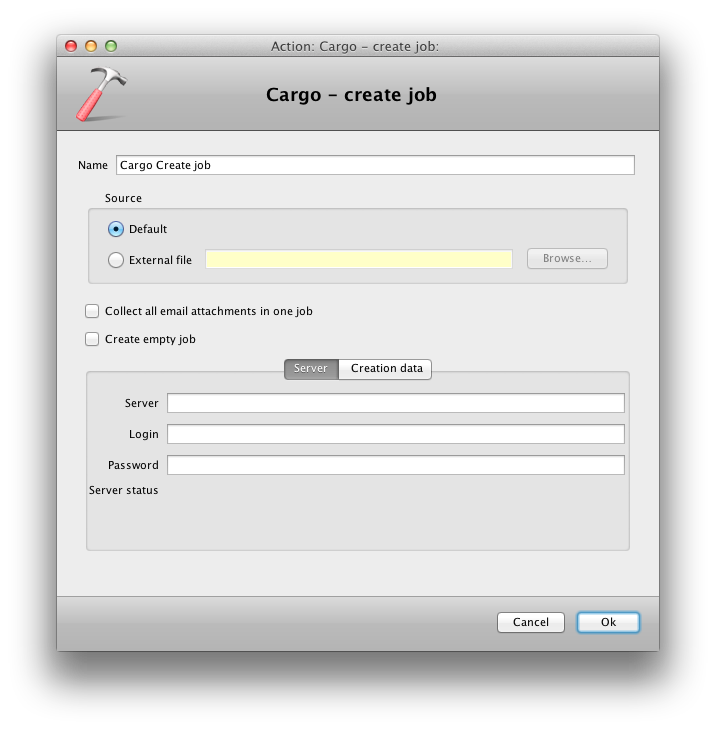
The settings for the Cargo create job action.
Cargo create job action preferences.
|
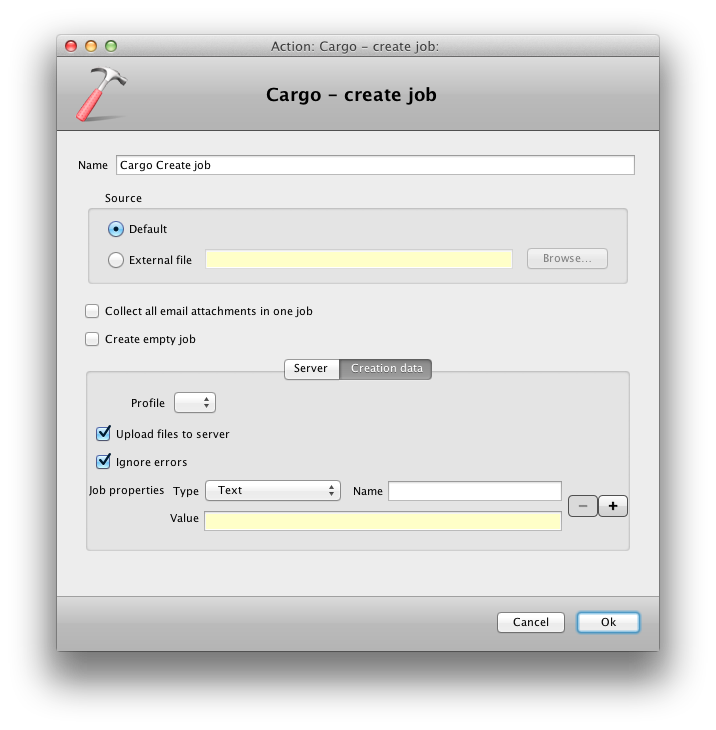
The settings for the Cargo create job action.
Cargo create job action preferences.
|
Settings
for the Cargo create job action
| Setting |
Description |
| Name |
The name for this component. This name is used throughout the rest of the settings in FileTrain and is acting as an identifier for the component. |
| Source - default |
The default source indicates that the action should be invoked on the object that is currently in scope. This is the normal way to use the action. |
| Source - external file |
This option is useful if you would like the action to be applied on another file than the one currently in scope. This is convenient for example if you have a sidecar file that needs to be handled or if the file that should be handled is referenced in a text file. |
| Collect all email attachments in one job |
This option is only useful when this action is part of a station where the source is an email source. If this option is selected, all the current email's attachment conforming to the filter in which this action is placed will be added to the job that is being created. The other attachments will be prevented to create their own jobs.
Example) If you have an email source and use a file filter with restriction size > 100 KiB and as action you have a Cargo Create Job with the option to collect all email attachments set. If an email has two attachments where both files are sized > 100 KiB, there will only be one job created where both the attachment files will be added. |
| Create empty job |
If this option is selected, the job will be created without any initial file in it. Any file/email attachment etc that are being handled in this action will not be added to the job. |
| Server |
The full http path to the Cargo servlet. Normally this servlet is located in the cargo folder on the web server and the name is 'cargoServlet'. The server path is case sensitive.
Example) http://localhost:8080/cargo/cargoServlet |
| Login |
The Cargo user login to use when connecting. The rest of the setup may depend on the login in terms of available profiles, status values etc. |
| Password |
The password for the Cargo login. |
| Profile |
The profile on the Cargo server to use when creating the job. The user in the login setting may have restricted access to the profiles on the Cargo server. |
| Upload files to server |
If this option is selected the files will be uploaded with HTTP to the Cargo server. Otherwise they will be handled from the location they currently have. |
| Ignore errors |
If this option is selected any error reported from the Cargo server will be ignored. |
| Job properties |
This is a set of job properties that will be set when adding the file. |
Cargo - update file action
Handles
Email
Files
Folders
This is a special action used in a system with Cargo.
The actions for Cargo requires a connection to a Cargo server. The connction is the full http path to the Cargo servlet. Normally this servlet is located in the cargo folder on the web server and the name is 'cargoServlet'. The server path is case sensitive.
When the cargo action is opened the action setup is trying to connect to the Cargo server to get necessary values from the server. If the user clicks the ok button before such a connection is made the settings may be damaged and the action may not work properly. Therefor it is important to always wait on the connection to finish. When the connection has finished the server tab is either showing a green check or a red cross to indicate successful or failed connection.
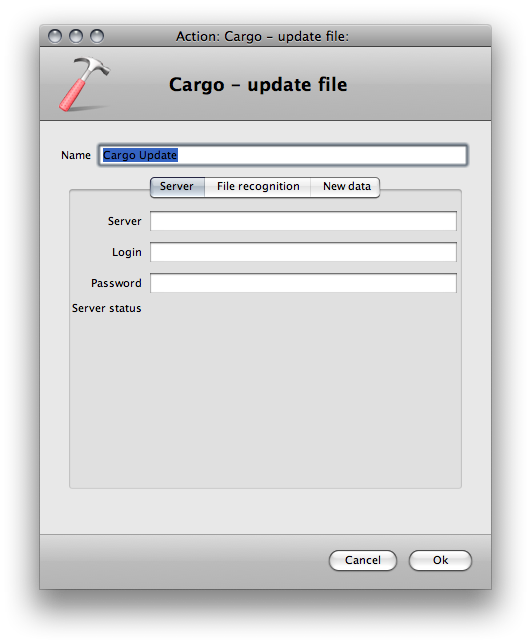
The settings for the Cargo update file action.
Cargo update file action preferences.
|
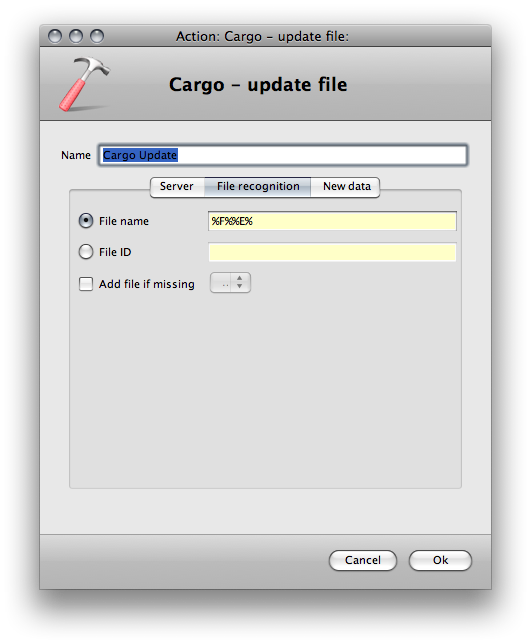
The settings for the Cargo update file action.
Cargo update file action preferences.
|

The settings for the Cargo update file action.
Cargo update file action preferences.
|
Settings
for the Cargo update file action
| Setting |
Description |
| Name |
The name for this component. This name is used throughout the rest of the settings in FileTrain and is acting as an identifier for the component. |
| Server |
The full http path to the Cargo servlet. Normally this servlet is located in the cargo folder on the web server and the name is 'cargoServlet'. The server path is case sensitive.
Example) http://localhost:8080/cargo/cargoServlet |
| Login |
The Cargo user login to use when connecting. The rest of the setup may depend on the login in terms of available profiles, status values etc. |
| Password |
The password for the Cargo login. |
| File name |
The file that should be updated could be identified with file name or Cargo file id. The file name field may be separated with a pipe character (|) in which case different file name options are available. |
| File ID |
If the Cargo file id is known this can be used to indicate which file that is being updated. |
| Add file if missing |
If the file is not found on the server it may be added to the selected profile (a new job with the file will be created). |
| Status |
The new status for the file that is being updated. If the selection 'do not change' is selected the status will stay the same as it is on the Cargo server. |
| Real location |
This is the current actual location of the file that is being updated (in order to create thumbnails and other data). Normally this would be %FILE_PATH% |
| Location |
This is the location that will be saved in the Cargo server to be the location of the file. Normally this would be %FILE_PATH% but if the file is mvoed to another location after this action this other location may be used instead. |
| Update thumbnail |
If this option is selected the Cargo server will update it's thumbnail and preview of the file. |
| Ignore errors |
If this option is selected any error reported from the Cargo server will be ignored. |
| Job/File properties |
This is a set of job/file properties that will be set when updating the file. |
Char converter action
Handles
Email
Files
Folders
This action will replace characters in a file name and then move the file to another destination. This action could be seen as a move action with the additional replacing of characters before the move.
To add conversion of characters you simply place the character(s) you want to replace in the 'From Character' field and in the 'To Character' field you enter what the new characters should be (leave empty if you want to remove the characters entered in the from field. Then you click the add button under the conversion list to add this replacement scheme. You may add as many conversions as you like.
There is also a UTF field for both the from and to fields. When you enter a character in the character field it's corresponding UTF value will be shown in the UTF field. If you enter more than one character the UTF field will have all the characters UTF values separated by comma (,). If you can not find the character you want to replace on your keyboard you may enter it's UTF value in the UTF field and the corresponding character will be shown in the character field.
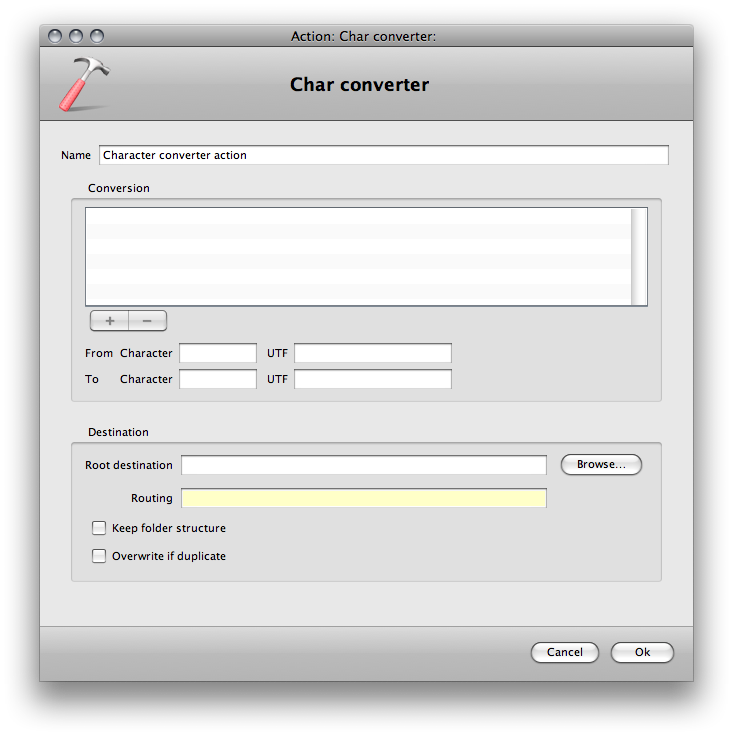
The settings for the character converter action.
The 'from' and 'to' character fields may contain more than one character. If there is more than one character the UTF fields will show each characters UTF value and the values will be separated with a comma (,).
Settings for the character converter action
| Setting |
Description |
| Name |
The name for this component. This name is used throughout the rest of the settings in FileTrain and is acting as an identifier for the component. |
| Conversion |
This list holds all the conversions. To add a new conversion, add the values in the from and to character fields (or use the UTF fields) and click the add button. To remove a conversion from the list, select it and click the remove button. |
| Root destination |
This is the root folder where the action will put the object. If the routing field (see below) is empty the object will be placed in the root destination, otherwise in a sub location described by the routing field. The location entered in this field must exist, see note for the routing field. |
| Routing |
Use this field to enter a sub location to the root destination. This field is a macro field and may contain macros. If you for example enter '%D%' in the routing field the final destination folder will be a sub folder with the current date in the root destination.
Note
The root destination must exist for the action to be executed correctly. The final destination folder created with the routing does not need to exists, it will be created if it is not present.
|
| Keep folder structure |
The folder structure is the sub folder structure seen from the source main folder where it applies.
Example: A folder source is set to watch folder A and also selected to search subfolders. The pdf file file.pdf is detected in the folder A/B/file.pdf. If the keep folder structure is selected the result file will be placed in the sub folder B also in the end location. |
| Overwrite if duplicate |
This option will first delete the duplicate, then replace it with the new one from this action.
See information of the special macro %DUPLICATE_FILE_EXTRA[...]% for more options regarding duplicate files. |
Command line action
Handles
Email
Files
Folders
This action will execute a command in the command shell environment on the computer.
The object that caused this action to execute is not affected by this action unless the command itself is having an effect on the object.
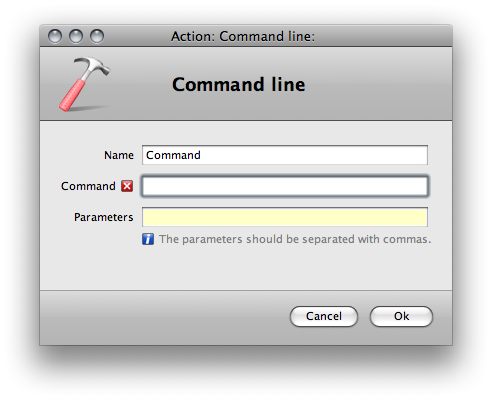
The settings for the command line action.
Settings for the command line action
| Setting |
Description |
| Name |
The name for this component. This name is used throughout the rest of the settings in FileTrain and is acting as an identifier for the component. |
| Command |
This is the main command to execute in the command prompt. |
| Parameters |
This is optional parameters to the command. Each parameter must be separated with a comma (,). |
Copy action
Handles
Email
Files
Folders
The copy action will copy a file to a new location. The original object will remain intact.

The settings for the copy action.
Settings for the copy action
| Setting |
Description |
| Name |
The name for this component. This name is used throughout the rest of the settings in FileTrain and is acting as an identifier for the component. |
| Source - default |
The default source indicates that the action should be invoked on the object that is currently in scope. This is the normal way to use the action. |
| Source - external file |
This option is useful if you would like the action to be applied on another file than the one currently in scope. This is convenient for example if you have a sidecar file that needs to be handled or if the file that should be handled is referenced in a text file. |
| Root destination |
This is the root folder where the action will put the object. If the routing field (see below) is empty the object will be placed in the root destination, otherwise in a sub location described by the routing field. The location entered in this field must exist, see note for the routing field. |
| Routing |
Use this field to enter a sub location to the root destination. This field is a macro field and may contain macros. If you for example enter '%D%' in the routing field the final destination folder will be a sub folder with the current date in the root destination.
Note
The root destination must exist for the action to be executed correctly. The final destination folder created with the routing does not need to exists, it will be created if it is not present.
|
| Name change |
If this field is having a value the object will get this name at the final location. This can for example be used to add a special prefix on the object. If we need to add the prefix 'A-' on the object we will put 'A-%F%%E%' in the name change field (see the section about macros for more information). |
| Keep folder structure |
The folder structure is the sub folder structure seen from the source main folder where it applies.
Example: A folder source is set to watch folder A and also selected to search subfolders. The pdf file file.pdf is detected in the folder A/B/file.pdf. If the keep folder structure is selected the result file will be placed in the sub folder B also in the end location. |
| Overwrite if duplicate |
This option will first delete the duplicate, then replace it with the new one from this action.
See information of the special macro %DUPLICATE_FILE_EXTRA[...]% for more options regarding duplicate files. |
| Ignore if source and destination are the same (size and modification time) |
If this option is selected the copying will not be performed if the destination file exists and is regarded to be the same (size and modification time are compared). |
| Create link |
If this option is selected the destination will be a link to the original file. |
| Set file modification time |
If this option is selected the copied file will get the current time as modification time. |
Database action
Handles
Email
Files
Folders
This action may be used to access and perform SQL calls or procedure/function calls.
Note that if a SQL call returns multiple result rows the full list of result rows will be put in a bucket. The key of this bucket is the same key as stated in the setup but with the trailing -list, e.g. if you have the following SQL query: SELECT paperName from paper and the result column paperName with bucket key pName, there will be a bucket key pName-list which holds all the values from the query. Use for example the macro %BUCKET_LIST[...]% to get all the values from this list.

The settings for the database connection action.
Database action preferences. |
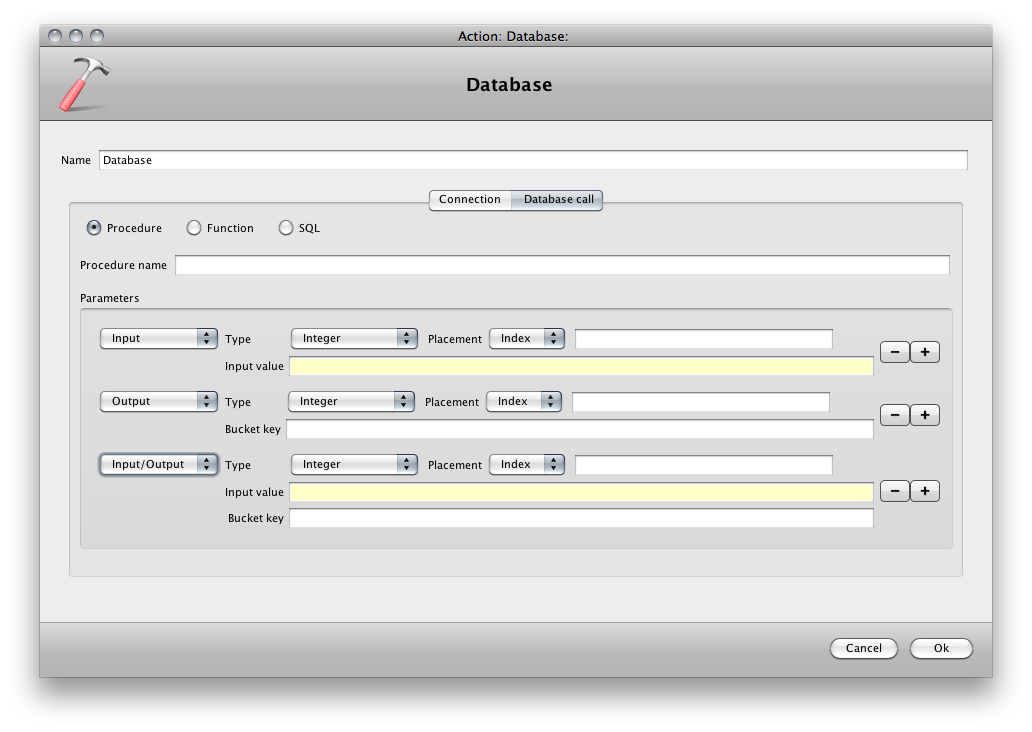
The settings for the database connection action.
Database action preferences. |
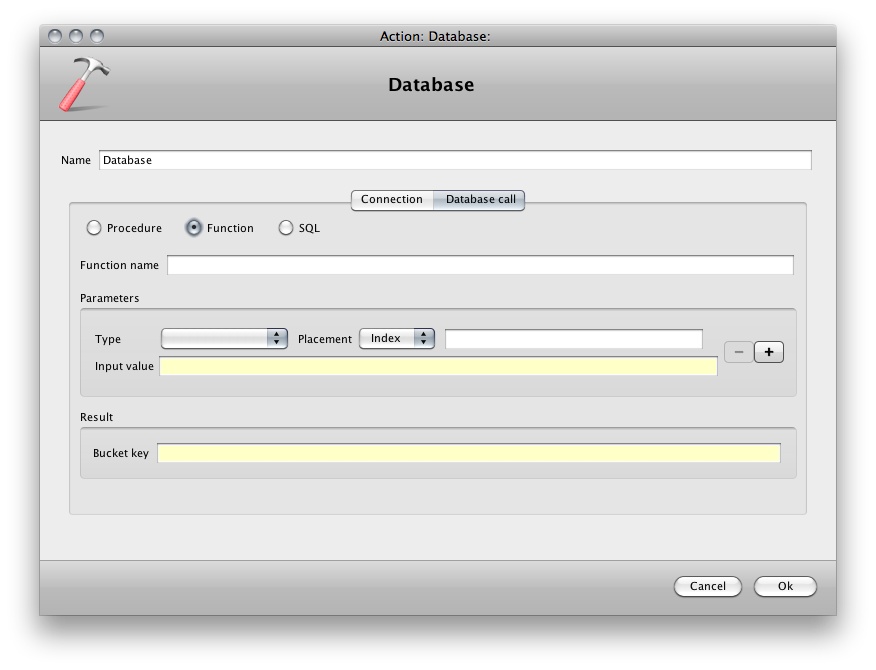
The settings for the database connection action.
Database action preferences. |
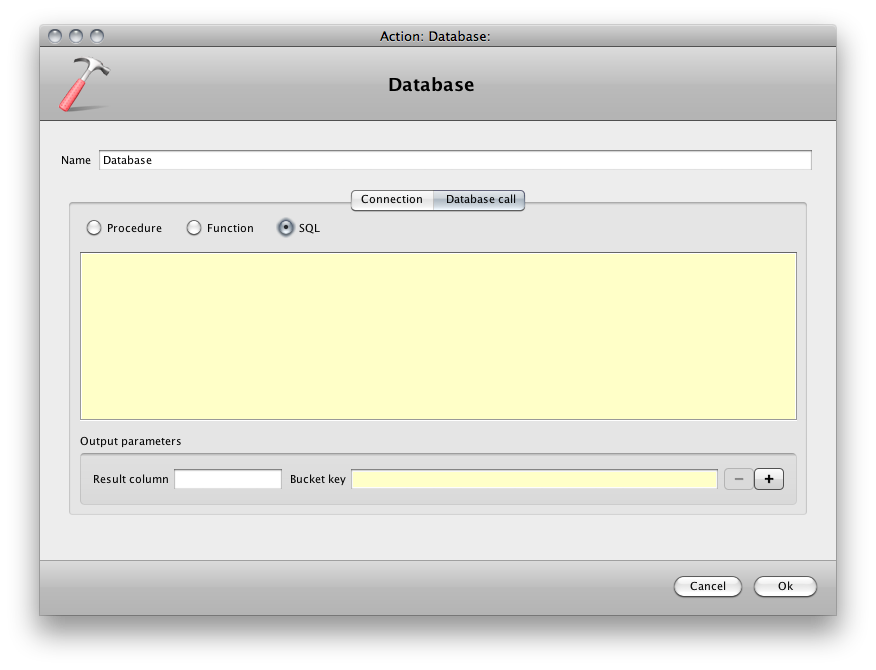
The settings for the database connection action.
Database action preferences. |
Settings for the database action
| Setting |
Description |
| Name |
The name for this component. This name is used throughout the rest of the settings in FileTrain and is acting as an identifier for the component. |
| Connection - Type |
The type of database, the default types are Oracle and MySQL. If any other database type is wanted, please contact Laidback Solutions AB. |
| Connection - Server address |
The IP number or DNS host name for the database server. |
| Connection - Port |
The port to use when connecting to the database server. |
| Connection - Database name (SID) |
The SID or database instance name to connect to. |
| Connection - Login |
The user login to use when connecting to the database server. |
| Connection - Password |
The password for the user login. |
| Database call |
The database action supports regular SQL calls, procedure calls and function calls with separate setups. |
| Procedure |
| Procedure name |
The name of the procedure in the database. |
| Parameters |
This is all the parameters to the procedure. Each parameter may be input, output or input/output.
The type of the parameter is the data type. The placement is eitther indexed or key based. If indexed, write the index of the parameter (starting at 1) in the field. If key based, write the key in the field.
For an input parameter there will be a field where the input value may be written. For output parameters there is a field for bucket key which enables to place the returned value in a specific bucket key. |
| Function |
| Function name |
The name of the function in the database. |
| Parameters |
This is all the parameters to the function.
The type of the parameter is the data type. The placement is eitther indexed or key based. If indexed, write the index of the parameter (starting at 1) in the field. If key based, write the key in the field.
The input value is the value to send to the function for this parameter. |
| Result |
The result of the function call may be placed in a special bucket key, specified in this field. |
| SQL |
| SQL |
Write yoru SQL call in the text area. |
| Output parameters |
If your call will return values you may collect these and place them in different bucket keys. Select the result column (please note that the case may be of importance depending on the database) and which bucket key to place the returned value in. |
Delete action
Handles
Email
Files
Folders
This action will delete an object. This action can handle both emails and files.
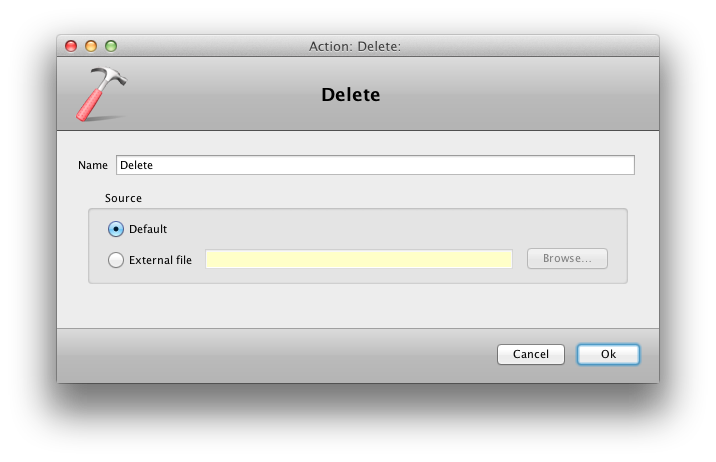
The settings for the delete action.
Settings for the delete action
| Setting |
Description |
| Name |
The name for this component. This name is used throughout the rest of the settings in FileTrain and is acting as an identifier for the component. |
| Source - default |
The default source indicates that the action should be invoked on the object that is currently in scope. This is the normal way to use the action. |
| Source - external file |
This option is useful if you would like the action to be applied on another file than the one currently in scope. This is convenient for example if you have a sidecar file that needs to be handled or if the file that should be handled is referenced in a text file. |
Email send action
Handles
Email
Files
Folders
This action will send an email. Note that there is a special action for sending email based on another email (see the email [email] action). The object that caused this action to execute is not affected by this action.
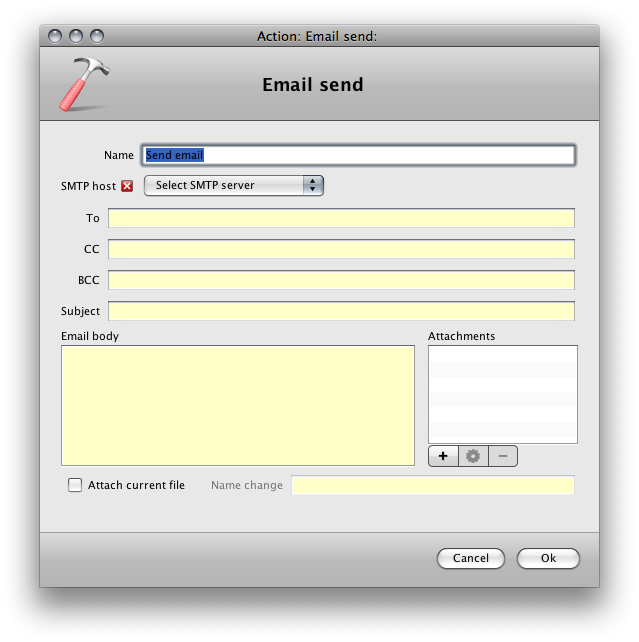
The settings for the email action.
Settings for the email action
| Setting |
Description |
| Name |
The name for this component. This name is used throughout the rest of the settings in FileTrain and is acting as an identifier for the component. |
| SMTP host |
The SMTP settings to use when sending the email. If no proper SMTP host has been setup, you may create a new one from this popup. |
| To, CC and BCC |
This is the list of receivers for the email. Comma separate different addresses
|
| Subject |
The email subject line. |
| Email body |
The email body text. This may be HTML formatted if surrounded by <html> and </html> |
| Attach current file |
If this checkbox is selected the file that caused the action to be executed will be attached to the email.
The name change field can be used to set a certain name of the file when it is being attached to the email (note that the file anme on disc will not be changed). |
| Other attachments |
This is a list of other static files to attach to the email. Note that the file location is a macro field and may therefor contain a path to a file with the same (or part of) file name as the file that caused the action to execute.
For each attachment a name change may be applied. This name change will only apply to the attachment file and will not change any file name on disc. |
Email Copy action
Handles
Email
Files
Folders
This action is only useful when the handled object is an email. This will make a copy of the email and put it in another email folder on the email server.
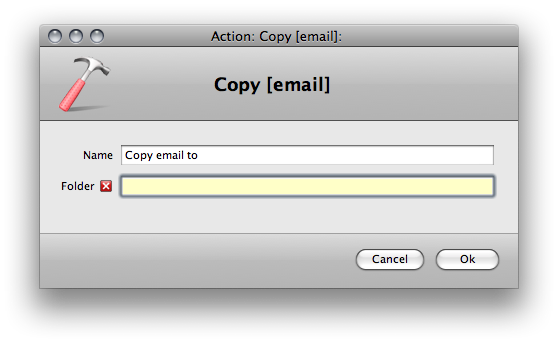
The settings for the copy [email] action.
Copy [email] action preferences.
Settings for the copy [email] action
| Setting |
Description |
| Name |
The name for this component. This name is used throughout the rest of the settings in FileTrain and is acting as an identifier for the component. |
| Folder |
The name of the folder on the email server to put this email. Note that the folder must be accessible with the same account that is used in the email source from where the email that is handled is coming. |
Email Move action
Handles
Email
Files
Folders
This action is only useful when the handled object is an email. This will move the email to another email folder on the email server.

The settings for the move [email] action.
Move [email] action preferences.
Settings for the move [email] action
| Setting |
Description |
| Name |
The name for this component. This name is used throughout the rest of the settings in FileTrain and is acting as an identifier for the component. |
| Folder |
The name of the folder on the email server to put this email. Note that the folder must be accessible with the same account that is used in the email source from where the email that is handled is coming. |
Expand action
Handles
Email
Files
Folders
The expand action is an old action and should not be used unless for back compatibility reasons.
For both Macintosh and Windows the Stuffit application does not need to be started. FileTrain will automatically control the running state of the Stuffit application.
Also note that Stuffit Expander may show an error dialog when a file is wrongly handled in Stuffit. This dialog must manually be removed whenever appearing.
Stuffit Expander is required
This action requires that Stuffit Expander is installed on the same machine as FileTrain.
Macintosh vs Windows
This action works slightly different on Macintosh compared to Windows, it is therefore extra important to know the settings in the action.
See the individual settings in the table below for more information about the differences between Windows and Macintosh.
Important
On Macintosh the Stuffit application must be set to always create a surrounding folder when expanding.
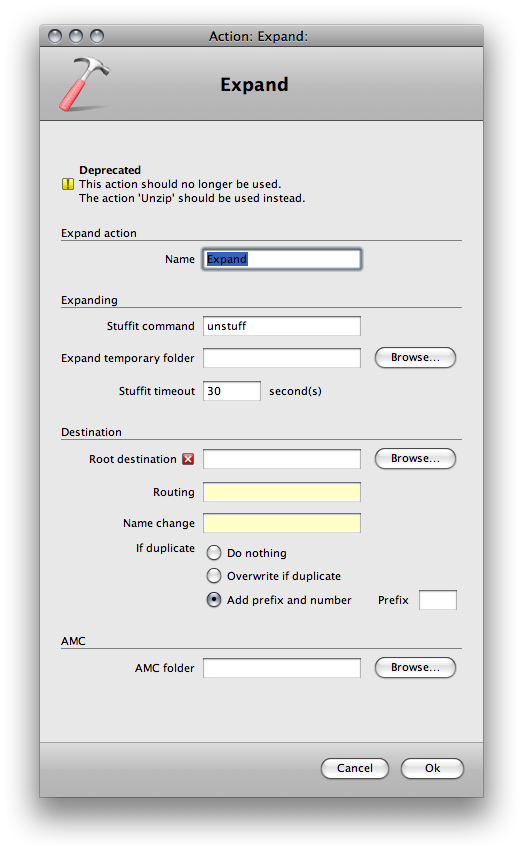
The settings for the expand action.
Settings for the expand action
| Setting |
Description |
| Name |
The name for this component. This name is used throughout the rest of the settings in FileTrain and is acting as an identifier for the component. |
| Stuffit command |
Only used on Windows. This is the command with which the Stuffit application is started. Older versions of Stuffit use unstuff and new versions may use other values. The command here is the command to start Stuffit through the console. |
| Expand temporary folder |
On windows this is the folder where FileTrain will put the intermediate unstuffed files before further handlling. On Macintosh the Stuffit Expander application must be set to expand to a certain destination folder and this folder should be the same as the one entered here. |
| Stuffit timeout |
This is the timeout in seconds to wait for Stuffit. If this timeout is reached and no result file is detected the action fails. |
| Root destination |
This is the root folder where the action will put the object. If the routing field (see below) is empty the object will be placed in the root destination, otherwise in a sub location described by the routing field. The location entered in this field must exist, see note for the routing field. |
| Routing |
Use this field to enter a sub location to the root destination. This field is a macro field and may contain macros. If you for example enter '%D%' in the routing field the final destination folder will be a sub folder with the current date in the root destination.
Note
The root destination must exist for the action to be executed correctly. The final destination folder created with the routing does not need to exists, it will be created if it is not present.
|
| Name change |
If this field is having a value the object will get this name at the final location. This can for example be used to add a special prefix on the object. If we need to add the prefix 'A-' on the object we will put 'A-%F%%E%' in the name change field (see the section about macros for more information). |
| If duplicate |
With this setting you may select what will happen if there is a duplicate of the final destination location. There are three options;
- Do nothing: This will cancel the action and leave the duplicate as it is.
- Overwrite: This option will first delete the duplicate, then replace it with the new one from this action.
- Add prefix and number: This option will leave the duplicate is it is. The new object from this action will be having an added number after the file name. If the prefix field is having a value this value will be added before the number.
Example with add prefix and number
If the prefix field has the value '-' (dash) and the final location file name was 'image.jpg' but this file already exists the new file will be named 'image-1.jpg'. The next file will be named 'image-2.jpg' and so on.
|
| AMC folder |
This is the folder where the expand action can find AMC files. If this folder is specified the action will try to find the corresponding AMC file for the file being expanded and update this AMC file with all the expanded file entries making the AMC file hold the information for these files as well as the containing archived file.
AMC files are special XML formated files used by Laidback Solutions in other workflow applications. These AMC files contains meta information about other files. |
Feedback Upload
Handles
Email
Files
Folders
This is a special action for uploading files to a Feedback Server.
The result from the upload will be saved in different bucket keys. Note that these keys are affected by the name of the action.
Bucket fields affected by the action
| Bucket key |
Value |
<name of action>-result |
0 if the upload was ok
-1 if there were errors on the server side
-2 if there were errors in FileTrain |
<name of action>-errorMessage |
The error message, if any |
<name of action>-pageCount |
The number of pages that were processed in this upload |
<name of action>-imageCount |
The number of images that were handled by the server |
<name of action>-response |
The full response from the server |
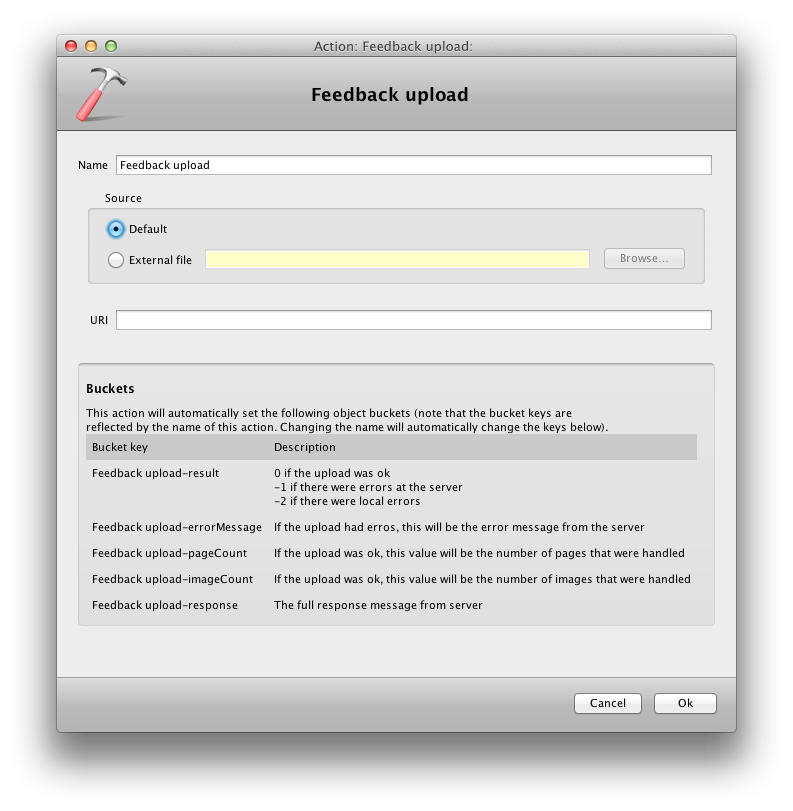
The settings for the FTP action.
Settings for the FTP action
| Setting |
Description |
| Name |
The name for this component. This name is used throughout the rest of the settings in FileTrain and is acting as an identifier for the component. |
| Source - default |
The default source indicates that the action should be invoked on the object that is currently in scope. This is the normal way to use the action. |
| Source - external file |
This option is useful if you would like the action to be applied on another file than the one currently in scope. This is convenient for example if you have a sidecar file that needs to be handled or if the file that should be handled is referenced in a text file. |
| URI |
The URI for the upload site on the Feedback Server, e.g. http://127.0.0.1/feedback/processpdf/upload.php |
For Each action
Handles
Email
Files
Folders
The 'for each' action is not an action itself but will invoke other actions on a set of items. The action must have a list in form of a text string where a certain delimiter marks each item. For each item in the list a set of actions will be invoked.
Example with static value
We want to create five text files. Each text file should be named with todays date followed by a dash (-) and an index (1 to 5).
One way to accomplish this would be to create a for each action with the following setup.
Value: 1:2:3:4:5
Delimiter: :
Bucket key: myIndex
Actions: A text action which have the following value in the file name field: %D%-%BUCKET[myIndex]%.txt
If you now change the value field in the example above to the following text: help:content:todo:wanted you will get four text files named
2013-02-04-help.txt
2013-02-04-content.txt
2013-02-04-todo.txt
2013-02-04-wanted.txt
If you create a separate text file which content is your list of values (e.g. the text file content may be help:content:todo:wanted) you can use this text file as source for the value in the for each action by using the macro %FILE_CONTENT[...]%
Example with value taken from database call
If we in the example above want to create text files based on a result from a database call we can use a database action combined with the macro %BUCKET_LIST[...]%.
Let's assume we have a database with a table named DETAILS and we have a column named publicationDates. We want to create text files with names taken from this column. We start with creating a database action where we get all the publicationDates (e.g. SELECT publicationDates from DETAILS). The database action has put the publicationDates in a bucket which we have named pDate. When the database action has multiple result FileTrain creates the additional bucket key pDate-list which is a list of all the values. This list is what we will use in our for each action.
We create the for each action with the following setup
Value: %BUCKET_LIST[pDate-list,#]%
Delimiter:#
Bucket key: pDate
Actions: A text action which have the following value in the file name field: %BUCKET[pDate]%.txt
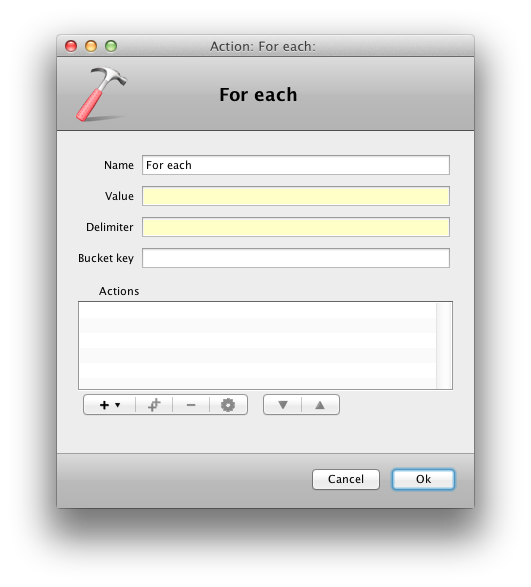
The settings for the 'for each' action.
'For each' action
Settings for the 'for each' action
| Setting |
Description |
| Name |
The name for this component. This name is used throughout the rest of the settings in FileTrain and is acting as an identifier for the component. |
| Value |
The value is the string that contains all the items which are used to loop the actions. Each item should be separated with the delimiter (see below). The value may be static text, a macro or a combination. There are some special macros which may be helpful setting the value.
|
| Delimiter |
The delimiter is the separator in the value string which separates each item. |
| Bucket key |
Each item in the value string separated by the delimiter will cause the actions to be invoked. The current value of the item will be saved in this bucket key and therefor accessible for the actions. |
| Actions |
This list contains all the actions that should be invoked on each item. |
FTP send action
Handles
Email
Files
Folders
The FTP action sends a file or folder to a certain FTP server using the file transfer protocol. This action will put some values in the station bucket which may be used by other actions. If a folder is being handled the folder itself might be omitted, i.e. the folder itself is not being sent to the FTP server.
The object that caused this action to execute is not affected by this action.
Important note about macro %DUPLICATE_FILE_EXTRA%
Please note that the macro %DUPLICATE_FILE_EXTRA% can not currently be used in this action setup.
Bucket fields affected by the FTP action
| Bucket key |
Value |
Comment |
FTPSendOkList-<name of action> |
List of the files that has been sent to the remote server. May contain both files and folders. |
The <name of action> is the name of the FTP action that is given in the preferences. If you for example has a FTP action that is named 'send images' the file list will be found in the bucket with key 'FTPSendOkList-send images'. |
FTPSendErrorList-<name of action> |
List of files that should have been sent but because of errors has not been able to be sent. May contain both files and folders. |
See above for information about <name of action>. |
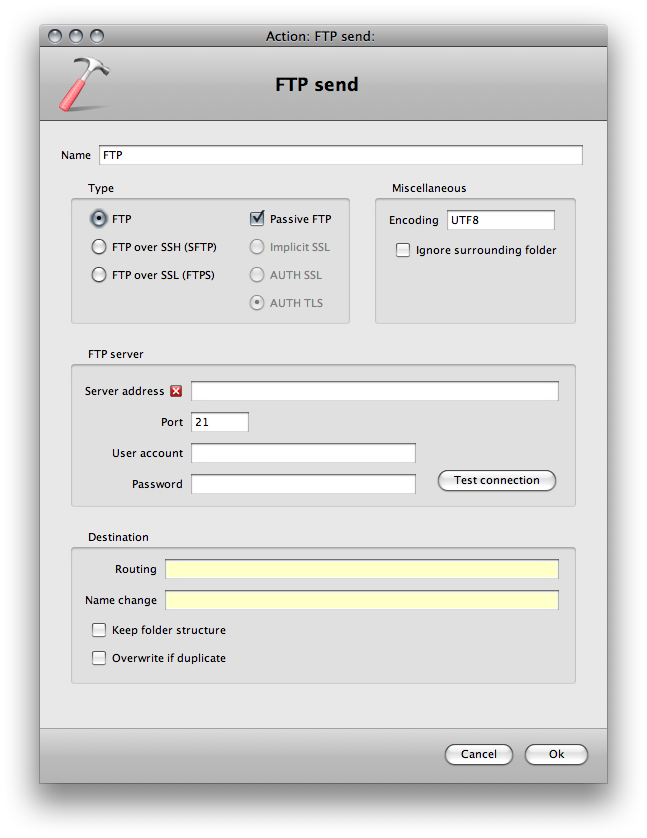
The settings for the FTP action.
Settings for the FTP action
| Setting |
Description |
| Name |
The name for this component. This name is used throughout the rest of the settings in FileTrain and is acting as an identifier for the component. |
| Type |
Select the type of transfer and individual setup for each type. |
| Encoding |
If the FTP server is using a special character encoding you may specify that here. Default, UTF8 is used. |
| Ignore surrounding folder |
If selected and the handling object is a folder, that folder itself is not sent to the FTP server, however all the content in the folder is sent. |
| Server address |
This is the address to the FTP server to send the object to. |
| Port |
The port on the FTP server to send to. Default FTP port is 21.
|
| User account |
The user login to the FTP server. If the server does not require any user name, use the name anonymous. |
| Password |
The password for the user account. Leave blank if no password is required. |
| Routing |
If the object should be put in any other directory than the default login folder that sub folder path should be entered here. |
| Name change |
Enter a new name if the name of the object should change on the final destination. |
| Keep folder structure |
The folder structure is the sub folder structure seen from the source main folder where it applies.
Example: A folder source is set to watch folder A and also selected to search subfolders. The pdf file file.pdf is detected in the folder A/B/file.pdf. If the keep folder structure is selected the result file will be placed in the sub folder B also in the end location. |
| Overwrite if duplicate |
This option will first delete the duplicate, then replace it with the new one from this action.
See information of the special macro %DUPLICATE_FILE_EXTRA[...]% for more options regarding duplicate files. |
Image processing [ImageMagick] action
Handles
Email
Files
Folders
This action is working with image files supported by ImageMagick.
This action may resize images in various ways and also change the format of a image from jpeg to png for example. More advanced color setup and handling of ICC profiles or adding text to an image may also be done.
Image format change
If the source file is in one format but the result file is wanted in another it is as simple as setting the name change to a proper name with the wanted file suffix.
If for example the source file is a jpeg but the result is wanted in png format, just enter %F%.png in the name change field and the result file will in fact be a png with the same name as the original file.
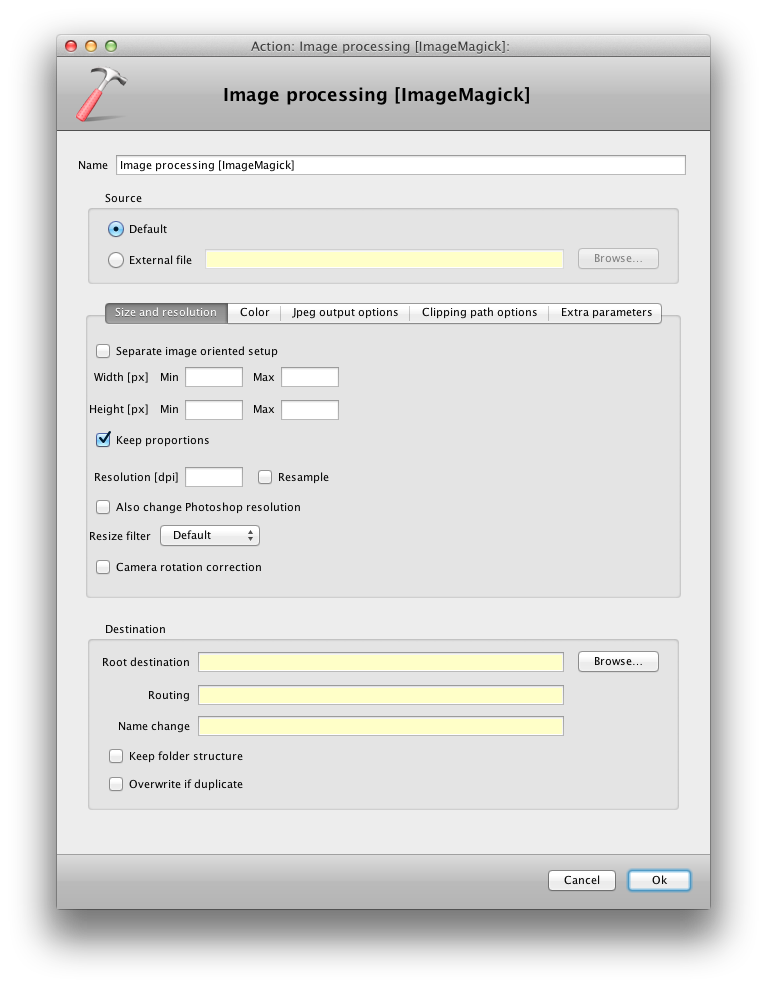
The settings for the image processing [ImageMagick] action.
Image processing [ImageMagick] action preferences.
|

The settings for the image processing [ImageMagick] action.
Image processing [ImageMagick] action preferences. |
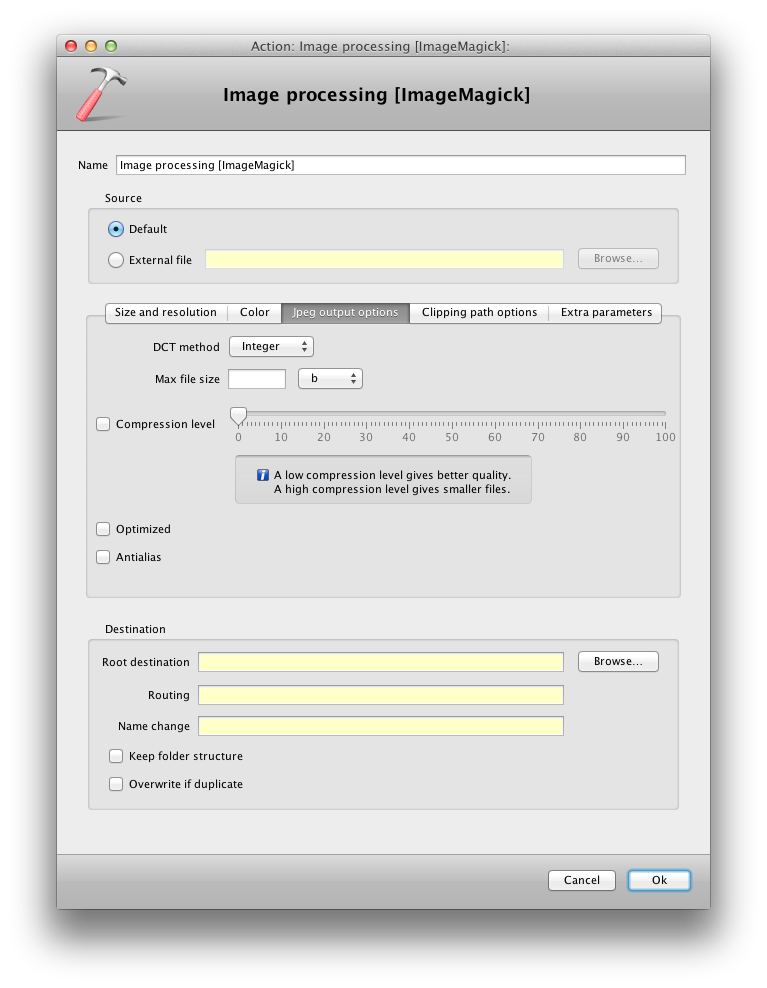
The settings for the image processing [ImageMagick] action.
Image processing [ImageMagick] action preferences. |
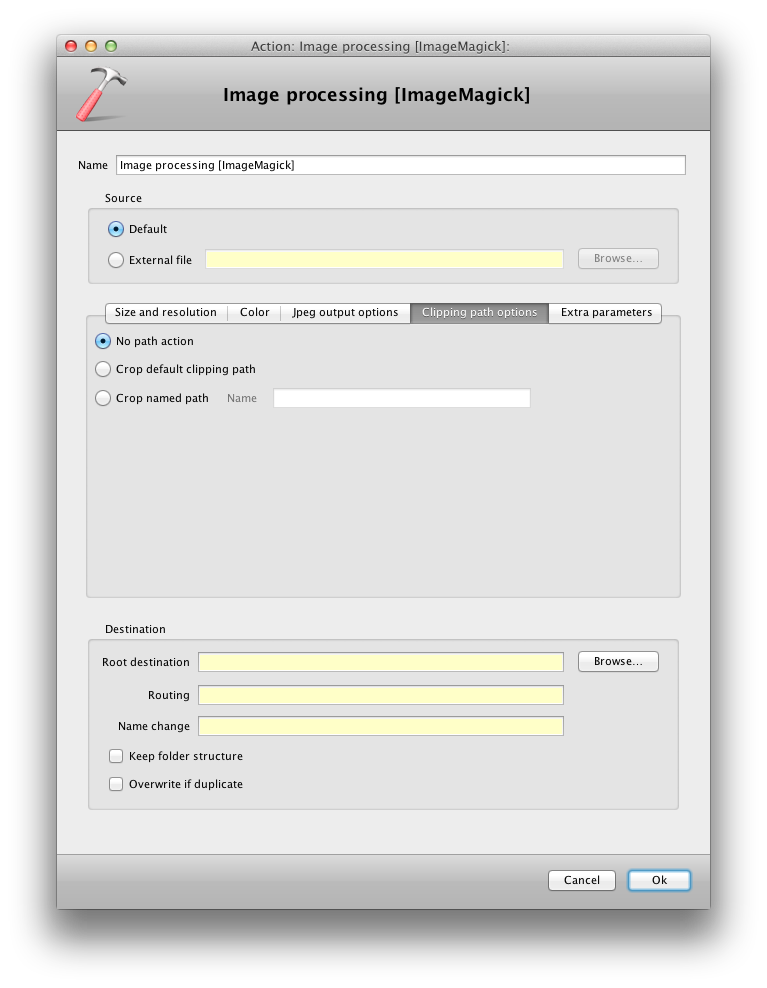
The settings for the image processing [ImageMagick] action.
Image processing [ImageMagick] action preferences. |
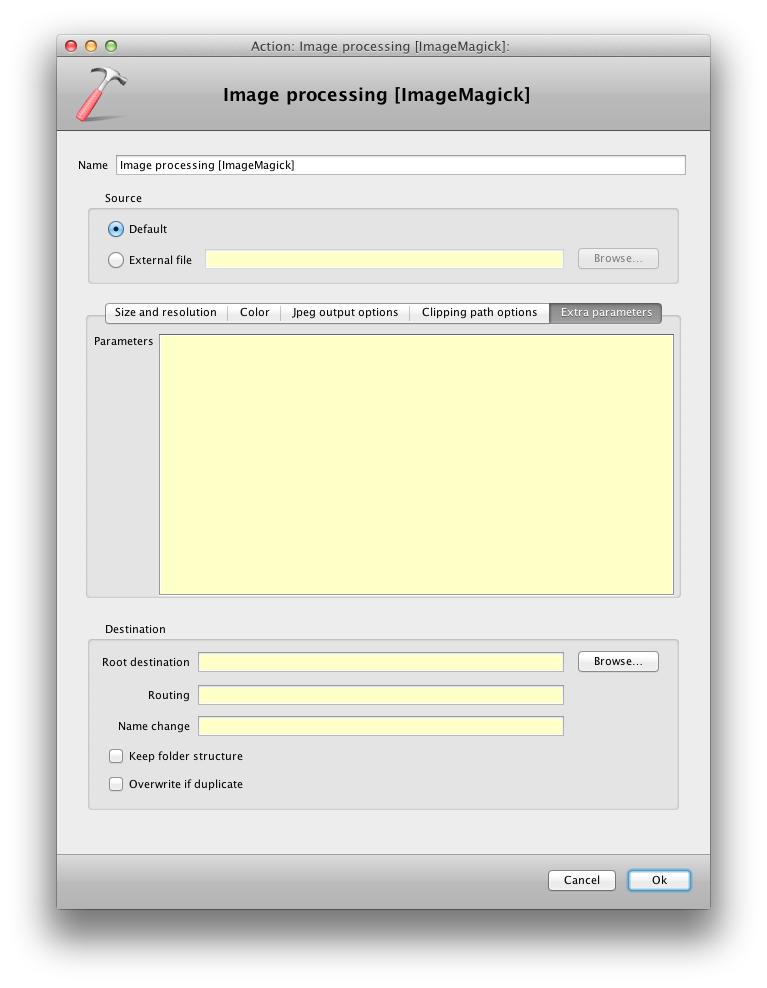
The settings for the image processing [ImageMagick] action.
Image processing [ImageMagick] action preferences. |
Settings for the Image processing [ImageMagick] action
| Setting |
Description |
Size and resolution
This panel shows setup for resizing options. |
| Name |
The name for this component. This name is used throughout the rest of the settings in FileTrain and is acting as an identifier for the component. |
| Source - default |
The default source indicates that the action should be invoked on the object that is currently in scope. This is the normal way to use the action. |
| Source - external file |
This option is useful if you would like the action to be applied on another file than the one currently in scope. This is convenient for example if you have a sidecar file that needs to be handled or if the file that should be handled is referenced in a text file. |
| Separate image oriented setup |
If this option is selected the resize options are divided into portrait and landscape options which may be setup differently. The different setups regards the source image, if the image is in landscape format (width>height) the landscape settings are applied. Note that the images may be having a rotation which is not applied before calculating the image format. |
| Width |
The min and max may be left empty or have a value (specified in pixels). If the min value is set the result image will at least have this width. If the max value is set the result image will not exceed this value. |
| Height |
This is similar to the width setting but for the height. |
| Keep proportions |
If this selection is checked the proportions of the source image will be kept. |
| Resolution |
The resolution in the result image (specified in dots per inch, DPI). This value may be left out and the resolution will not be changed. If the resample checkbox is selected the image will be resampled with this new resolution. |
| Also change Photoshop resolution |
The Photoshop application are reading different resolutino flags than those changed in the regular resolution. To get Photoshop to show the new resolution this checkbox must be selected. This alsso require Exiftool to be installed. If this choice is selected and no Exiftool is found by FileTrain the user will be asked to install the bundled version of Exiftool that comes with FileTrain. |
| Resize filter |
This is the method to use when resizing the image. |
Color space
This panel contains setup to change the color space or to insert a specific ICC profiel. |
| Color space |
Select the output color space if you like to change it. |
| ICC |
If a file is selected this file will be inserted in the image and used as the ICC profile. |
Jpeg output options
If the output format is jpg some extra setup may be specified in this panel. |
| DCT method |
This is the method to use as the discrete cosine transformation when the output is a jepg image. |
| Max file size |
You may specify a max file size for the output. Note that this opion is not always that accurate. |
| Compression level |
The level of compression in the output file. A low compression gives a better quality but also a bigger file size. If the checkbox is not selected the compression level will not change. |
| Optimized |
Select this box to make the jpeg output optimized. |
| Antialias |
Select this box to make the jepg output antialiased. |
Clipping path options
This panel contains setup to crop the image speicied by a clipping path. |
| No path action |
This is the default option and means that no handling of clipping paths will occur. |
| Crop default clipping path |
Select this option if you want the result image to be cropped (rectangularly) according to the default clipping path. |
| Crop named path |
Select this option if you want the result image to be cropped (rectangularly) according to a specificly named clipping path. |
Extra parameters
In this area you specify any extra parameter that you would like to send to ImageMagick. |
| Parameters |
Enter the parameters as they would be in a command line interface. |
Destination
In this area you specify where the result image should be written. Note that if you use a name change with a new file suffix the actually file format is changed. |
| Root destination |
This is the root folder where the action will put the result image. If the routing field (see below) is empty the object will be placed in the root destination, otherwise in a sub location described by the routing field. The location entered in this field must exist, see note for the routing field. |
| Routing |
Use this field to enter a sub location to the root destination. This field is a macro field and may contain macros. If you for example enter '%D%' in the routing field the final destination folder will be a sub folder with the current date in the root destination.
Note
The root destination must exist for the action to be executed correctly. The final destination folder created with the routing does not need to exists, it will be created if it is not present.
|
| Name change |
If this field is having a value the object will get this name at the final location. This can for example be used to add a special prefix on the object. If we need to add the prefix 'A-' on the object we will put 'A-%F%%E%' in the name change field (see the section about macros for more information). |
| Keep folder structure |
The folder structure is the sub folder structure seen from the source main folder where it applies.
Example: A folder source is set to watch folder A and also selected to search subfolders. The pdf file file.pdf is detected in the folder A/B/file.pdf. If the keep folder structure is selected the result file will be placed in the sub folder B also in the end location. |
| Overwrite if duplicate |
This option will first delete the duplicate, then replace it with the new one from this action.
See information of the special macro %DUPLICATE_FILE_EXTRA[...]% for more options regarding duplicate files. |
Image processing [SoftColor] action
Handles
Email
Files
Folders
This action is working with image files to produce a new image file based on the setup seen below. This action is only available on Windows since SoftColor is only available for the Windows platform.
Note that SoftColor is a third party application which must be purchased separately from FileTrain.
For information about the individual settings, please see the SoftColor documentation found online at http://www.softcolor.fi/.

The settings for the image processing [SoftColor] action.
Image processing [SoftColor] action preferences.
|

The settings for the image processing [SoftColor] action.
Image processing [SoftColor] action preferences. |
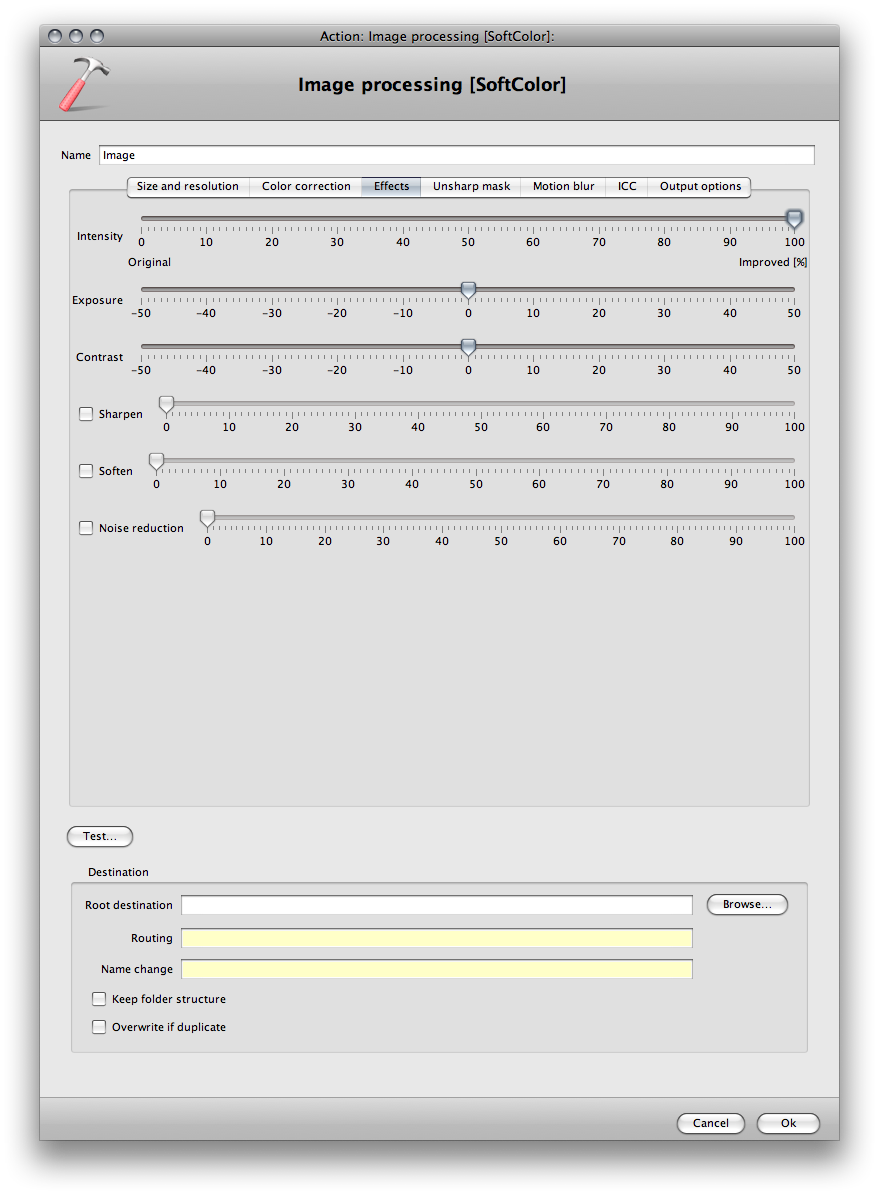
The settings for the image processing [SoftColor] action.
Image processing [SoftColor] action preferences. |
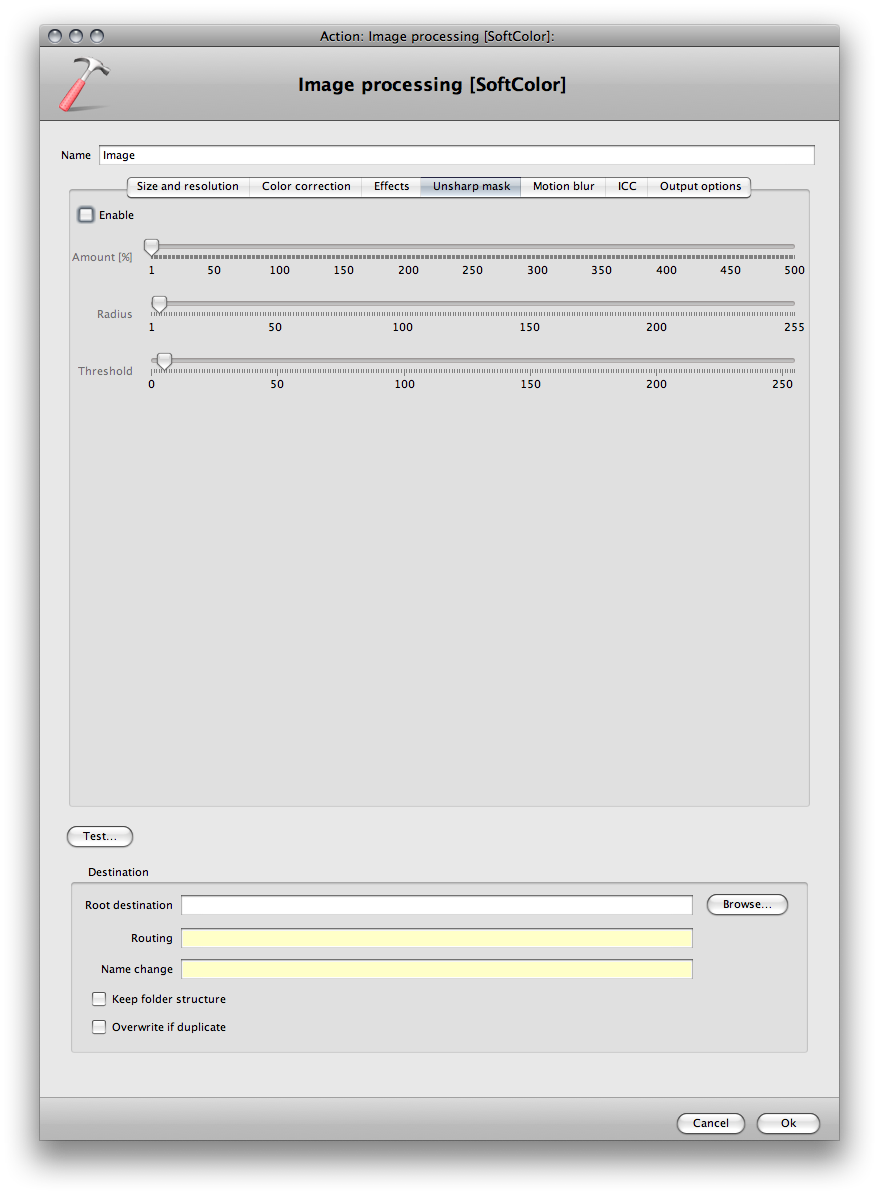
The settings for the image processing [SoftColor] action.
Image processing [SoftColor] action preferences. |

The settings for the image processing [SoftColor] action.
Image processing [SoftColor] action preferences. |
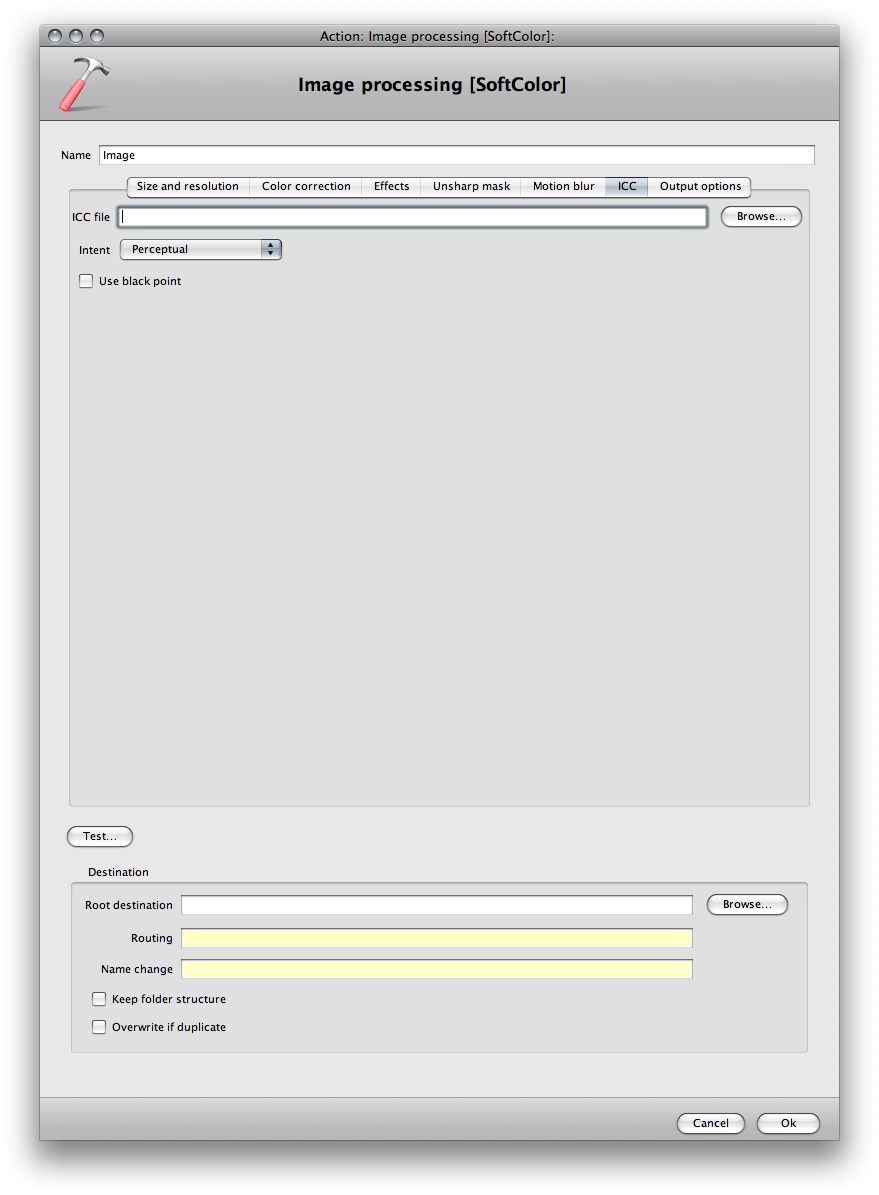
The settings for the image processing [SoftColor] action.
Image processing [SoftColor] action preferences. |

The settings for the image processing [SoftColor] action.
Image processing [SoftColor] action preferences. |
Settings for the Image processing [SoftColor] action
| Setting |
Description |
| Name |
The name for this component. This name is used throughout the rest of the settings in FileTrain and is acting as an identifier for the component. |
| Size and resolution |
See the SoftColor documentation for detailed information. |
| Color correction |
See the SoftColor documentation for detailed information. |
| Effects |
See the SoftColor documentation for detailed information. |
| Unsharp mask |
See the SoftColor documentation for detailed information. |
| Motion blur |
See the SoftColor documentation for detailed information. |
| ICC |
See the SoftColor documentation for detailed information. |
| Output options |
See the SoftColor documentation for detailed information. |
| Destination |
| Setting |
Description |
| Root destination |
This is the root folder where the action will put the result image. If the routing field (see below) is empty the object will be placed in the root destination, otherwise in a sub location described by the routing field. The location entered in this field must exist, see note for the routing field. |
| Routing |
Use this field to enter a sub location to the root destination. This field is a macro field and may contain macros. If you for example enter '%D%' in the routing field the final destination folder will be a sub folder with the current date in the root destination.
Note
The root destination must exist for the action to be executed correctly. The final destination folder created with the routing does not need to exists, it will be created if it is not present.
|
| Name change |
If this field is having a value the object will get this name at the final location. This can for example be used to add a special prefix on the object. If we need to add the prefix 'A-' on the object we will put 'A-%F%%E%' in the name change field (see the section about macros for more information). |
| Keep folder structure |
The folder structure is the sub folder structure seen from the source main folder where it applies.
Example: A folder source is set to watch folder A and also selected to search subfolders. The pdf file file.pdf is detected in the folder A/B/file.pdf. If the keep folder structure is selected the result file will be placed in the sub folder B also in the end location. |
| Overwrite if duplicate |
This option will first delete the duplicate, then replace it with the new one from this action.
See information of the special macro %DUPLICATE_FILE_EXTRA[...]% for more options regarding duplicate files. |
IPTC inserter action
Handles
Email
Files
Folders
The IPTC action is only guaranteed to work on JPG and TIFF files. This action will insert new IPTC information into the files with the possibillity to keep the old values.
To handle the insertion click the add button under the conversion list. This will open a dialog where the IPTC field can be choosen and the insertion text added. There is an option in this dialog to replace, append or precede the old value with the new value.

The settings for the IPTC inserter action.
Settings for the IPTC inserter action
| Setting |
Description |
| Name |
The name for this component. This name is used throughout the rest of the settings in FileTrain and is acting as an identifier for the component. |
| Source - default |
The default source indicates that the action should be invoked on the object that is currently in scope. This is the normal way to use the action. |
| Source - external file |
This option is useful if you would like the action to be applied on another file than the one currently in scope. This is convenient for example if you have a sidecar file that needs to be handled or if the file that should be handled is referenced in a text file. |
| Conversion |
This list contains all the insertions that should be done. To add a new insertion, click the add button under the list. To remove an existing insertion, select it in the list and click the delete button. To edit an existing insertion, select it and click the edit button. |
Move action
Handles
Email
Files
Folders
This action will move the object to a new location.
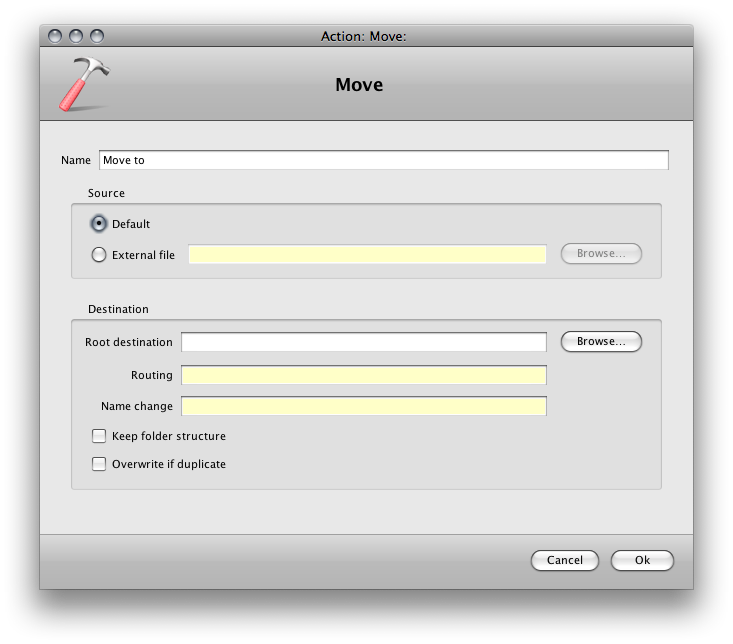
The settings for the move action.
Settings for the move action
| Setting |
Description |
| Name |
The name for this component. This name is used throughout the rest of the settings in FileTrain and is acting as an identifier for the component. |
| Source - default |
The default source indicates that the action should be invoked on the object that is currently in scope. This is the normal way to use the action. |
| Source - external file |
This option is useful if you would like the action to be applied on another file than the one currently in scope. This is convenient for example if you have a sidecar file that needs to be handled or if the file that should be handled is referenced in a text file. |
| Root destination |
This is the root folder where the action will put the object. If the routing field (see below) is empty the object will be placed in the root destination, otherwise in a sub location described by the routing field. The location entered in this field must exist, see note for the routing field. |
| Routing |
Use this field to enter a sub location to the root destination. This field is a macro field and may contain macros. If you for example enter '%D%' in the routing field the final destination folder will be a sub folder with the current date in the root destination.
Note
The root destination must exist for the action to be executed correctly. The final destination folder created with the routing does not need to exists, it will be created if it is not present.
|
| Name change |
If this field is having a value the object will get this name at the final location. This can for example be used to add a special prefix on the object. If we need to add the prefix 'A-' on the object we will put 'A-%F%%E%' in the name change field (see the section about macros for more information). |
| Keep folder structure |
The folder structure is the sub folder structure seen from the source main folder where it applies.
Example: A folder source is set to watch folder A and also selected to search subfolders. The pdf file file.pdf is detected in the folder A/B/file.pdf. If the keep folder structure is selected the result file will be placed in the sub folder B also in the end location. |
| Overwrite if duplicate |
This option will first delete the duplicate, then replace it with the new one from this action.
See information of the special macro %DUPLICATE_FILE_EXTRA[...]% for more options regarding duplicate files. |
QuarkXPress PDF renderer action
Handles
Email
Files
Folders
This action will render a PDF from a QuarkXPress document. The result PDF is placed in selected location. This action will connect to a QuarkXPress Server. When connected the current Quark document in scope will be uploaded to the QXPS document pool, rendered as a PDF and finally deleted from the document pool.
Bucket fields affected by the QuarkXPress action
| Bucket key |
Value |
Comment |
<name of action>-linkedFiles |
List of the files that has been found as linked files. The list is separated with ', ' |
The <name of action> is the name of the FTP action that is given in the preferences. If you for example has an action that is named 'convert' the file list will be found in the bucket with key 'convert-linkedFiles'. |
<name of action>-linkedMissingFiles |
List of the files that has been detected as linked files and are not found. The list is separated with ', ' |
See above for information about <name of action>. |
| <name of action>-linkedFoundFiles |
List of the files that has been detected as linked files and are found. The list is separated with ', ' |
See above for information about <name of action>. |
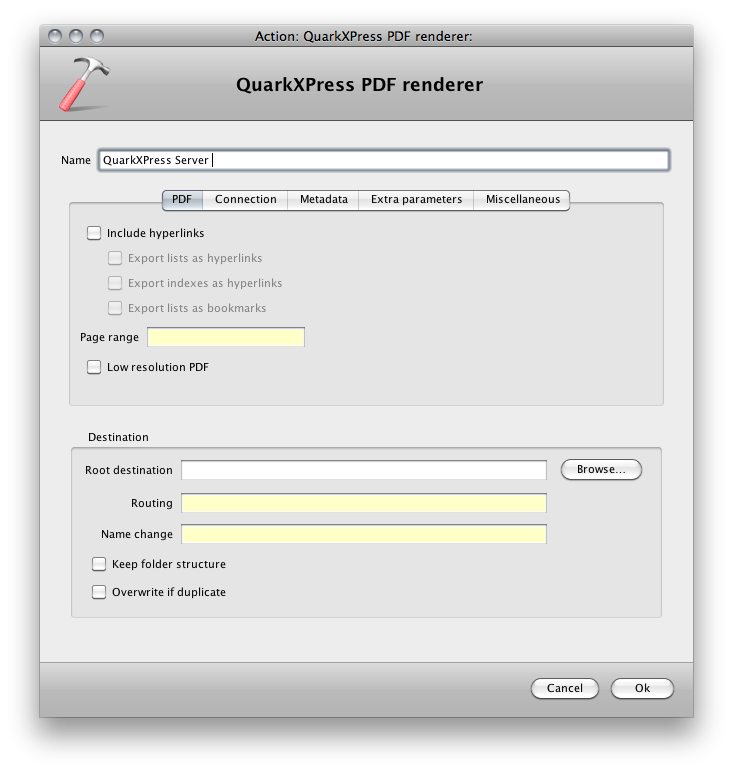
The settings for the QuarkXPress PDF render action.
QuarkXPress PDF render action preferences. |

The settings for the QuarkXPress PDF render action.
QuarkXPress PDF render action preferences. |
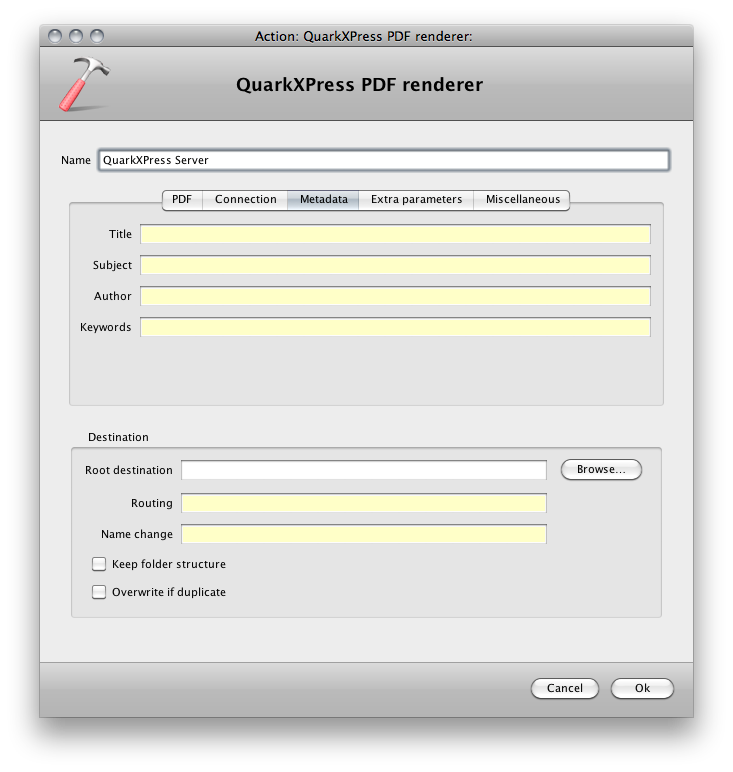
The settings for the QuarkXPress PDF render action.
QuarkXPress PDF render action preferences. |

The settings for the QuarkXPress PDF render action.
QuarkXPress PDF render action preferences. |
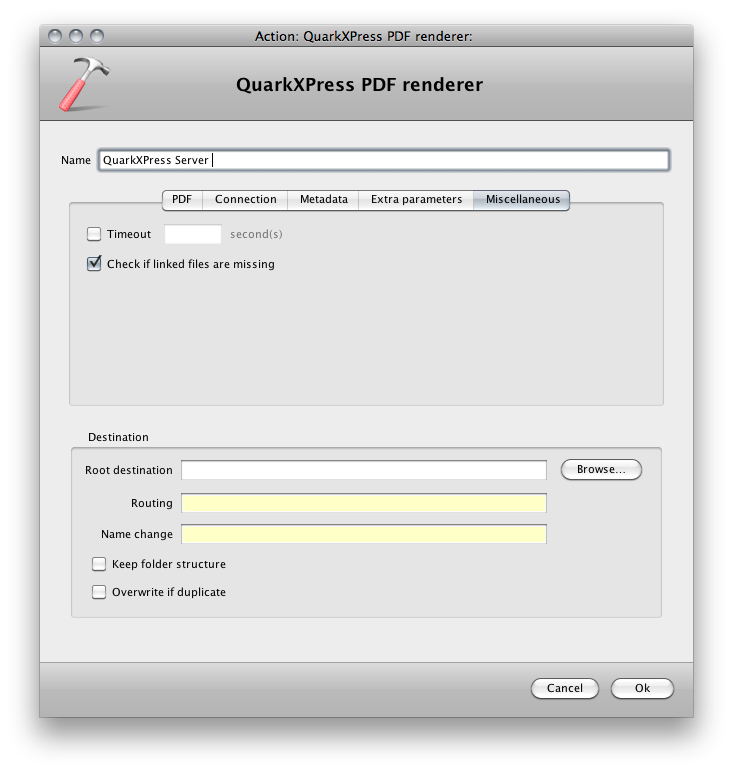
The settings for the QuarkXPress PDF render action.
QuarkXPress PDF render action preferences. |
Settings for the QuarkXPress PDF render action
| Setting |
Description |
| Name |
The name for this component. This name is used throughout the rest of the settings in FileTrain and is acting as an identifier for the component. |
| PDF - include hyperlinks |
Specifies whether hyperlinks should be included in the PDF document. |
| PDF - export lists as hyperlinks |
Specifies whether lists should be exported as hyperlinks. |
| PDF - export indexes as hyperlinks |
Specifies whether the index should be exported as hyperlinks. |
| PDF - export lists as bookmarks |
Specifies whether lists should be exported as bookmarks. |
| PDF - page range |
If not all the pages should be rendered you may enter the page range, e.g. 1-3. |
| PDF - low resolution PDF |
If this checkbox is selected the rendered PDF will be low resolution. |
| Connection - server address |
The server address where the QuarkXPress Server is located. |
| Connection - port |
The port on which the QuarkXPress Server is listening. |
| Metadata - title |
Additional title information in the PDF. |
| Metadata - subject |
Additional subject information in the PDF. |
| Metadata - author |
Additional author information in the PDF. |
| Metadata - keywords |
Additional keywords information in the PDF. |
| Extra parameters |
In this tab you may enter any additional parameter key-value pair to the QuarkXPress Server (see the QuarkXPress Server web integration documentation for more information about parameters available). |
| Miscellaneous - Timeout |
If this option is selected and the time is set, this will be used as timeout before action fails. |
| Miscellaneous - Check if linked files are missing |
If this option is selected, FileTrain will do an internal search for the linked files. If selected, please note that the files will be searched for from the FileTrain server. |
| Root destination |
This is the root folder where the action will put the final PDF file. If the routing field (see below) is empty the PDF will be placed in the root destination, otherwise in a sub location described by the routing field. The location entered in this field must exist, see note for the routing field. |
| Routing |
Use this field to enter a sub location to the root destination. This field is a macro field and may contain macros. If you for example enter '%D%' in the routing field the final destination folder will be a sub folder with the current date in the root destination.
Note
The root destination must exist for the action to be executed correctly. The final destination folder created with the routing does not need to exists, it will be created if it is not present.
|
| Name change |
If this field is having a value the PDF will get this name at the final location. This can for example be used to add a special prefix on the object. If we need to add the prefix 'A-' on the object we will put 'A-%F%.pdf' in the name change field (see the section about macros for more information). |
| Keep folder structure |
The folder structure is the sub folder structure seen from the source main folder where it applies.
Example: A folder source is set to watch folder A and also selected to search subfolders. The pdf file file.pdf is detected in the folder A/B/file.pdf. If the keep folder structure is selected the result file will be placed in the sub folder B also in the end location. |
| Overwrite if duplicate |
This option will first delete the duplicate, then replace it with the new one from this action.
See information of the special macro %DUPLICATE_FILE_EXTRA[...]% for more options regarding duplicate files. |
File permission action
Handles
Email
Files
Folders
This action will try to change the file permission rights the object. This action is only available on Macintosh.

The settings for the file permission action.
Settings for the file persmission action
| Setting |
Description |
| Name |
The name for this component. This name is used throughout the rest of the settings in FileTrain and is acting as an identifier for the component. |
| File permissions |
If a checkbox is selected it means that the rights for that particular user (either owner, group or other) for the particular action (read, write or execute) will be set. |
Stop station action
Handles
Email
Files
Folders
This action will immediately stop the station.

The settings for the stop station action.
Settings for the stop station action
| Setting |
Description |
| Name |
The name for this component. This name is used throughout the rest of the settings in FileTrain and is acting as an identifier for the component. |
Storage action
Handles
Email
Files
Folders
This action is a modified version of the copy action. The action will copy the object to a new location but will in this location create folders to put the object in. When a folder is 'full' the next object will be placed in another folder with a new index. This means that the folder to where the object should be moved can be limited in size or number of items. This action is very handy if you for example collect your files into archives with certain sizes.
Example - create CD archives:
You want to create an archive but each folder in the archive must not exceed the size of a CD-ROM (700 MB). We select a root destination and then enter a name in the sub destination. In this example we will use 'CD %DUPLICATE_FILE_EXTRA[%FREE_INDEX%]%'. We set the size limit to 700 MB.
When the first object is handled it will end up in the folder 'CD' (sub folder to the root folder). All the coming objects will end up in this until an object that can't fit in this folder is handled. When this object is handled a new folder 'CD 1' will be created and the object will end up in this.
If a new object will fit in the first folder it will end up there even if a latter folder has been created. This will make sure that the folders are filled up to a maximum.
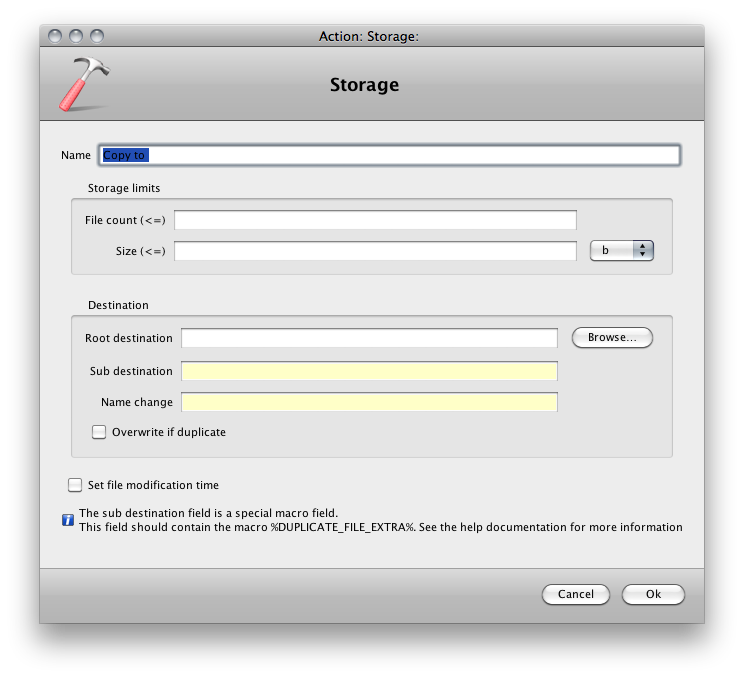
The settings for the storage action.
Settings for the storage action
| Setting |
Description |
| Name |
The name for this component. This name is used throughout the rest of the settings in FileTrain and is acting as an identifier for the component. |
| Storage limits |
This is the limits that the destination folders will be set to have. You may enter a count limit meaning that the number of items in the destination folder can not exceed that number.
You may also set the size limit, meaning the total file size in the destination folder.
These limits may be set individually or both at the same time. If both limits are set a new destination folder is created when any of the limits are reached. |
| Root destination |
This is the root folder where the action will put the object. If the routing field (see below) is empty the object will be placed in the root destination, otherwise in a sub location described by the routing field. The location entered in this field must exist, see note for the routing field. |
| Sub destination |
This is the path to the sub location. This field is a macro field and may contain macros. If you for example enter '%D%' in this field the final destination folder will be a sub folder with the current date in the root destination.
This field must contain the macro %DUPLICATE_FILE_EXTRA[...]% in which the macro %FREE_INDEX% us useful which will be replaced by a running number for the storage location.
Note
The root destination must exist for the action to be executed correctly. The final destination folder created with the routing does not need to exists, it will be created if it is not present.
|
| Name change |
If this field is having a value the object will get this name at the final location. This can for example be used to add a special prefix on the object. If we need to add the prefix 'A-' on the object we will put 'A-%F%%E%' in the name change field (see the section about macros for more information). |
| Overwrite if duplicate |
This option will first delete the duplicate, then replace it with the new one from this action.
See information of the special macro %DUPLICATE_FILE_EXTRA[...]% for more options regarding duplicate files. |
| Set file modification time |
If this option is selected the copied file will get the current time as modification time. |
Text file action
Handles
Email
Files
Folders
This action will create a text file in any format. This action will not affect the object that caused this action to execute.

The settings for the text file action.
Settings for the text file action
| Setting |
Description |
| Name |
The name for this component. This name is used throughout the rest of the settings in FileTrain and is acting as an identifier for the component. |
| Text |
The text that will be created. This text may contain macros and the text can be in any format. |
| Append |
If this option is selected the original file content will be kept and the text will be appended to the current file content. |
| Text format |
The format which should be used when writing the file. The default value is UTF-8.
The value generally follows the conventions documented in RFC 2278: IANA Charset Registration Procedures. The value is not case-sensitive. |
| Root destination |
This is the root folder where the action will put the object. If the routing field (see below) is empty the object will be placed in the root destination, otherwise in a sub location described by the routing field. The location entered in this field must exist, see note for the routing field. |
| Routing |
Use this field to enter a sub location to the root destination. This field is a macro field and may contain macros. If you for example enter '%D%' in the routing field the final destination folder will be a sub folder with the current date in the root destination.
Note
The root destination must exist for the action to be executed correctly. The final destination folder created with the routing does not need to exists, it will be created if it is not present.
|
| File name |
The file name of the created text file. If this name is missing the name will be taken from the object being handled but with the file extension .txt. |
| Keep folder structure |
The folder structure is the sub folder structure seen from the source main folder where it applies.
Example: A folder source is set to watch folder A and also selected to search subfolders. The pdf file file.pdf is detected in the folder A/B/file.pdf. If the keep folder structure is selected the result file will be placed in the sub folder B also in the end location. |
| Overwrite if duplicate |
This option will first delete the duplicate, then replace it with the new one from this action.
See information of the special macro %DUPLICATE_FILE_EXTRA[...]% for more options regarding duplicate files. |
Unzip action
Handles
Email
Files
Folders
This action will unzip a file and put the result files in a final destination.
This action will not affect the source zip file so if the source file is not needed after the unzip a delete action should be set after this action.
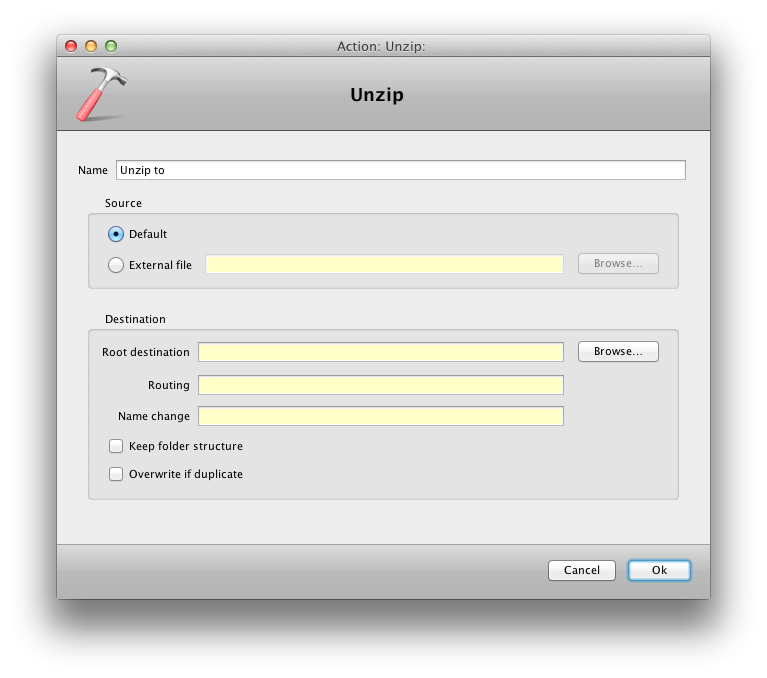
The settings for the unzip action.
Settings for the unzip action
| Setting |
Description |
| Name |
The name for this component. This name is used throughout the rest of the settings in FileTrain and is acting as an identifier for the component. |
| Source - default |
The default source indicates that the action should be invoked on the object that is currently in scope. This is the normal way to use the action. |
| Source - external file |
This option is useful if you would like the action to be applied on another file than the one currently in scope. This is convenient for example if you have a sidecar file that needs to be handled or if the file that should be handled is referenced in a text file. |
| Root destination |
This is the root folder where the action will put the unzipped files. If the routing field (see below) is empty the files will be placed in the root destination, otherwise in a sub location described by the routing field. The location entered in this field must exist, see note for the routing field. |
| Routing |
Use this field to enter a sub location to the root destination. This field is a macro field and may contain macros. If you for example enter '%D%' in the routing field the final destination folder will be a sub folder with the current date in the root destination.
Note
The root destination must exist for the action to be executed correctly. The final destination folder created with the routing does not need to exists, it will be created if it is not present.
|
| Name change |
The name change regards the unzipped files. See the special macro %ZIPF% for information how to use the original zip file's name for the result files. This field may be empty in which case the files will keep their original names. |
| Keep folder structure |
The folder structure is the sub folder structure seen from the source main folder where it applies.
Example: A folder source is set to watch folder A and also selected to search subfolders. The pdf file file.pdf is detected in the folder A/B/file.pdf. If the keep folder structure is selected the result file will be placed in the sub folder B also in the end location. |
| Overwrite if duplicate |
This option will first delete the duplicate, then replace it with the new one from this action.
See information of the special macro %DUPLICATE_FILE_EXTRA[...]% for more options regarding duplicate files. |
Wait action
Handles
Email
Files
Folders
This action will wait and hold the current process until a certain condition is fulfilled.
To avoid that the process is stalled forever the setup has a timeout setting.
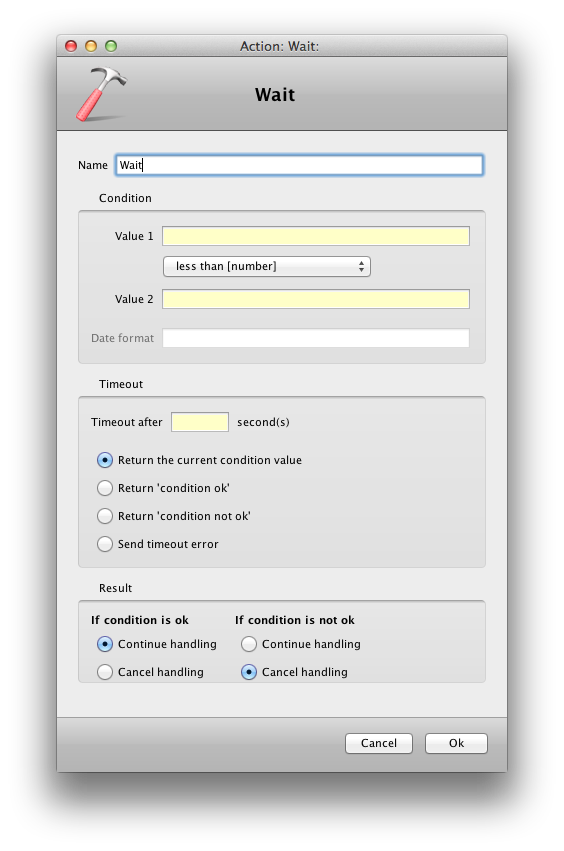
The settings for the wait action.
Wait action preferences.
Settings for the wait action
| Setting |
Description |
| Name |
The name for this component. This name is used throughout the rest of the settings in FileTrain and is acting as an identifier for the component. |
Condition
This is the setup for which the action will wait until it is fulfilled. An alternative timeout may be set to avoid an eternal wait. |
| Value 1 and Value 2 |
The values to be calculated and compared. The popup between the values will set how the values will be compared.
Example) If value 1 is set to "1" and value 2 is set to "2" and the comparison is set to "equals" this will mean that the condition is fulfilled and the wait will return immediately. |
| Date format |
If the comparison popup has been set to compare two dates, this field will be enabled and you may set the date format for the values that are to be compared |
Timeout
If a timeout is set, and the condition is not fulfilled until the timeout is reached this section will decide what will happen. |
| Timeout after |
This is the timeout in seconds. |
| Return the current condition value |
If this option is selected when the timeout is reached a final check is made of the condition and if the condition is true, the result will be handled as 'ok' |
| Return 'condition ok' |
If this option is selected the timeout will mean that the result will be forced to 'ok' |
| Return 'condition not ok' |
If this option is selected the timeout will mean that the result will be forced to 'not ok' |
| Send timeout error |
This will cause the action to send an error (remaining actions will not be performed). Additional setup for the error may be done in the station's error setup. |
Result
This is what will happen when this action is done performing (unless the send timeout error is selected and timeout is happening).
The 'If condition is ok' is what will happen if the condition is fulfilled (either that the condition is actually ok or timeout setting is set to force an ok). The 'If condition is not ok' will be executed if the condition was not ok or timeout was forcing a 'not ok'.
Continue handling will mean that the station will continue the workflow as usual. Cancel handling will force the station to cancel the remaining actions. |
XMP inserter action
Handles
Email
Files
Folders
The XMP action is only tested to work on JPG, TIFF and PDF files. This action will insert new XMP information into the files with the possibillity to keep the old values.
To handle the insertion click the add button under the list. This will open a dialog where the XMP field can be choosen and the insertion text added. There is an option in this dialog to replace, append or precede the old value with the new value.
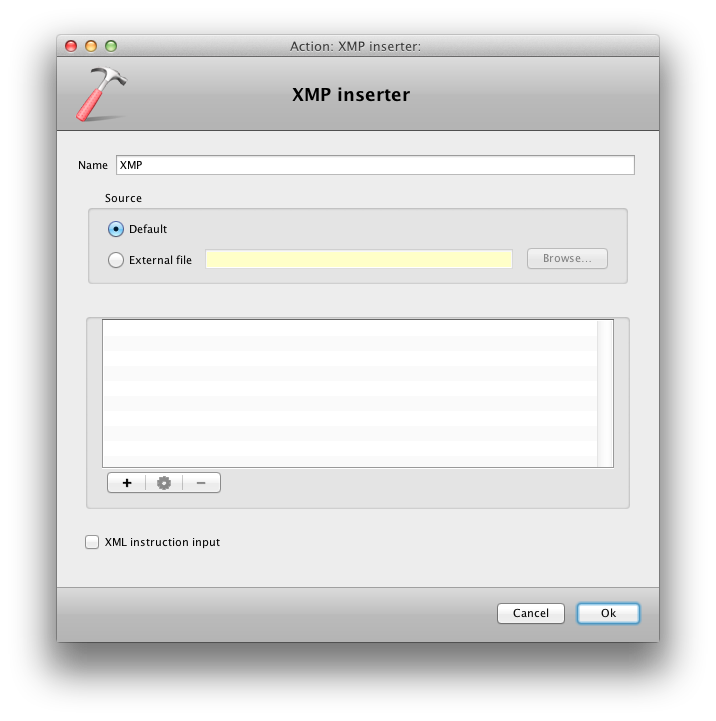
The settings for the XMP inserter action.
Settings for the XMP inserter action
| Setting |
Description |
| Name |
The name for this component. This name is used throughout the rest of the settings in FileTrain and is acting as an identifier for the component. |
| Source - default |
The default source indicates that the action should be invoked on the object that is currently in scope. This is the normal way to use the action. |
| Source - external file |
This option is useful if you would like the action to be applied on another file than the one currently in scope. This is convenient for example if you have a sidecar file that needs to be handled or if the file that should be handled is referenced in a text file. |
| Inserter list |
This list contains all the insertions that should be done. To add a new insertion, click the add button under the list. To remove an existing insertion, select it in the list and click the delete button. To edit an existing insertion, select it and click the edit button. |
3.6 SMTP servers
In some components in FileTrain there are settings involving SMTP servers. These settings will have a popup with all the available SMTP hosts created and the user may also create a new SMTP host from those popups. All the SMTP host settings are collected in the SMTP preferences area.
When testing the connection you may see a warning that a certain certificate is used (if using SSL), you may select to enable this certificate or not.
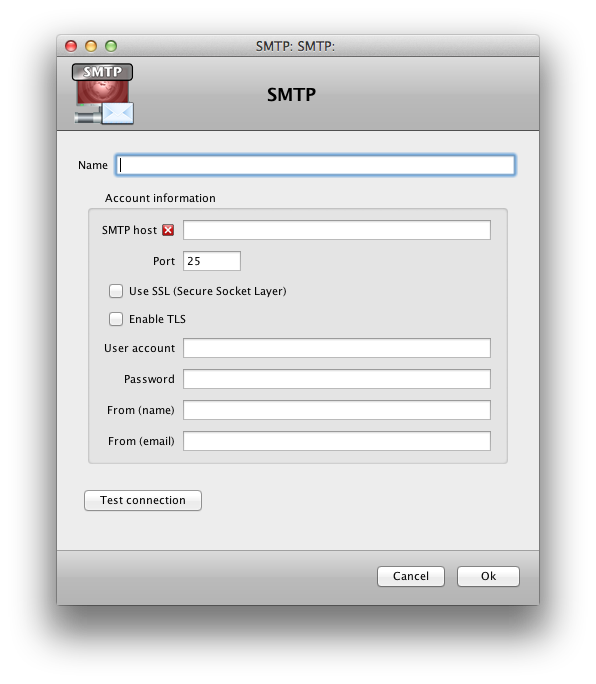 SMTP preferences
SMTP preferences
Settings for a SMTP host
| Setting |
Description |
| Name |
The name for this component. This name is used throughout the rest of the settings in FileTrain and is acting as an identifier for the component. |
| SMTP host |
The SMTP server name as IP number or DNS name, e.g. 192.168.40.3 or smtp.yourserver.com. |
| Port |
The SMTP server port. The default SMTP port is 25. |
| Use SSL |
If this check box is selected FileTrain will use the secure socket layer whilst communicating with the SMTP server. |
| Enable TLS |
Enabling TLS communication with the email server |
| User account |
The user login for the SMTP server. |
| Password |
The password for the user account above. |
| From (name) |
The personal name for the 'from' field in the email. |
| From (email) |
The email address which will be the address from which the email is seen sent from. |
3.7 Customized IPTC
The image handling in FileTrain includes IPTC reading and writing. FileTrain comes with a default set of IPTC fields, the standard fields. Additional to these standard IPTC fields you may add custom IPTC fields in FileTrain to read and write to non-standard IPTC values.
In various settings where IPTC fields are required there is a popup menu with all the default and the custom IPTC fields. From this popup it is also possible to create new custom IPTC fields. In the customized IPTC part of the configuration you may view the custom IPTC fields. Here you can add, remove and edit the custom IPTC fields. All the custom IPTC fields which are created with the special IPTC popup will appear in this area.
Custom IPTC
Make sure that all custom IPTC fields that are added in the FileTrain setup have unique IPTC field numbers. The numbers used in the custom IPTC must also not collide with any standard IPTC field number.
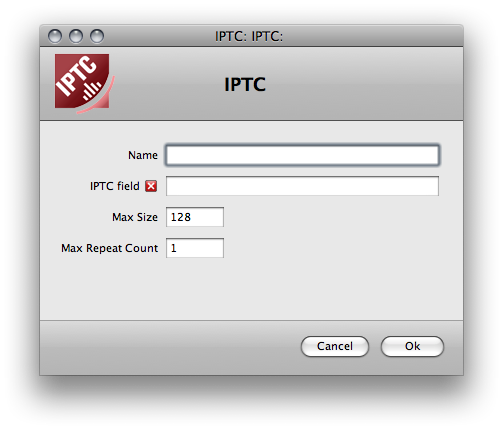 IPTC preferences.
IPTC preferences.
Settings for a custom IPTC field
| Setting |
Description |
| Name |
The name for this component. This name is used throughout the rest of the settings in FileTrain and is acting as an identifier for the component. |
| IPTC field |
The IPTC field number. This number must be a unique number and not be the same as another custom IPTC field or any of the standard IPTC fields. |
| Max size |
The maximum number of bytes that this IPTC field should be. Some IPTC fields may only contain 1 byte while others may contain several kB of text. |
| Max repeat count |
This is the maximum number of repeats that this field may occur in the IPTC data. Some IPTC fields may occur only one time while others may have several entries. |
3.8 Customized XMP
FileTrain has a default set of XMP fields which may be used to get values from or set the values to. There are many more XMP fields available since each company may define their own XMP fields. In FileTrain you may add one or more customized XMP fields to comply with such fields that are not in the default list of FileTrain.
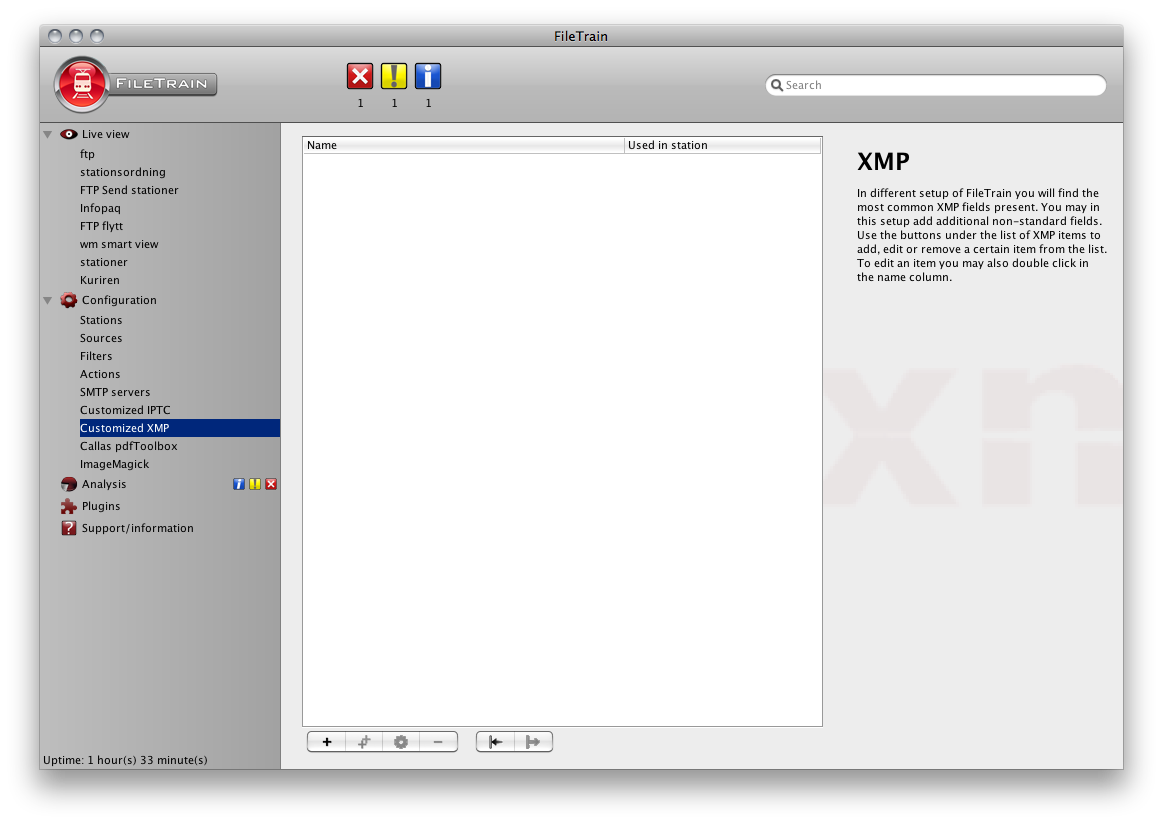
The customized XMP settings.
XMP preferences.When you add or edit a customized XMP field you will get the setup dialog for that XMP field, as seen below.
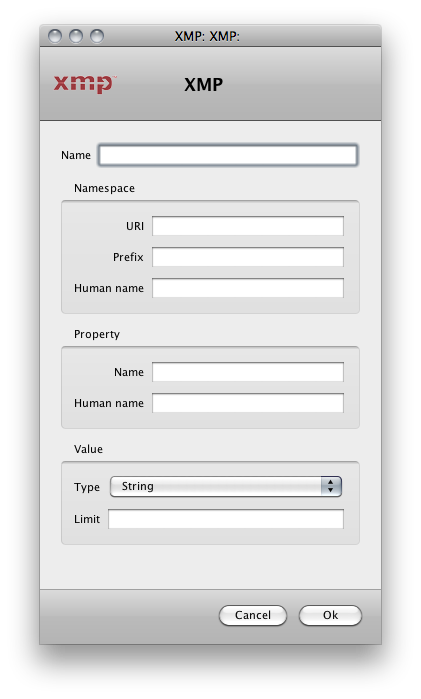
The customized XMP field settings.
XMP field setup.To setup the XMP field you will need to enter all the details.
Settings for a custom IPTC field
| Setting |
Description |
| Name |
The name for this XMP field. This name is only a name to show in the customized XMP field list and has no technical purpose. |
Namespace |
| URI |
The namespace URI is the specific URI to identify the XMP group. See the documentation from the supplier for the URI details.
Example) For the TIFF group this URI is http://ns.adobe.com/tiff/1.0/ |
| Prefix |
The namespace URI is not used when writing the XMP data, instead a prefix is used for this particular namespace, see the documentation from the supplier about the certain prefix used.
Example) For TIFF XMP the prefix is tiff |
| Human name |
This is used in the setup throughout FileTrain where this particular XMP field is shown. |
Property |
| Name |
The name of the property in the XML. See the documentation from the supplier for the details.
Example) For the TIFF XMP the compression has the property name Compression. |
| Human name |
This is used in the setup throughout FileTrain where this particular XMP field is shown. |
Value |
| Type |
Select the type of the property, see the documentation from the suppolier for details.
Example) For the TIFF XMP the compression has the type Integer. |
| Limit |
If the property has a certain value limit, this may be set here. use comma separated list to set a list of values. Use a comma to set a span of values.
Example) For the TIFF XMP the compression may have a integer value ranging from 1 to 6. The limit would therefor be 1:6. |
3.9 External Tools
Depending on the setup of your FileTrain there may be external tools needed. If you have a setup which uses external tools you will be prompted a warning in the FileTrain main window if that tool can not be found by FileTrain. This warning will also contain (as a tooltip) where in your setup the tool is used.
FileTrain tries to locate all external tools automatically but in some cases you may have to do some manual setup in order to locate the correct tool.
Each external tool may have individual setup which you can see by clicking on the button 'Show more' on the right hand side of each external tool.
If the setup is correct and FileTrain is able to locate the tool you will see the version of that tool.
Note that the external tools are not included or shipped with FileTrain, they must be downloaded/purchased from external source.
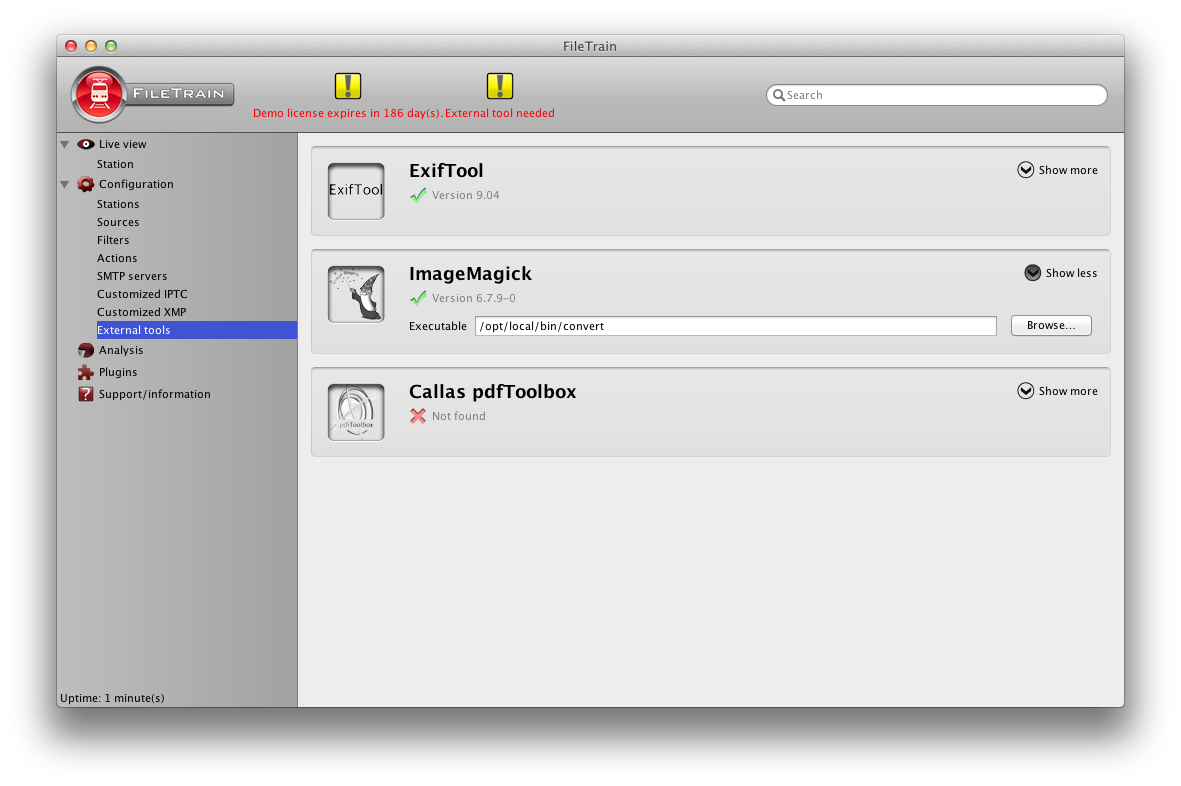 The External Tools setup
The External Tools setup
Settings for external tool - Exiftool
| Setting |
Description |
| Executable |
Here you select the executable file for Exiftool |
Settings for external tool - ImageMagick
| Setting |
Description |
| Executable |
Here you select the executable file for ImageMagick.
NB! On Macintosh OSX you may have to set the executable manually and the path is then most likely the following
/opt/local/bin/convert |
Settings for external tool - Callas pdfToolbox
| Setting |
Description |
| Executable |
Here you select the executable file for Callas pdfToolbox. |
| Callas profiles folder |
The folder where the profiles for Callas pdfToolbox are located. |
| Temporary folder |
The folder to use for temporary repository |
3.10 XMP
In FileTrain there are some standard XMP fields added. The following namespaces are currently supported except for those properties stated below. See the section about customized XMP to add your own XMP fields.
XMP Basic (http://ns.adobe.com/xap/1.0/)
The property thumbnails is not yet supported.
Dublin Core (http://purl.org/dc/elements/1.1/)
EXIF (http://ns.adobe.com/exif/1.0/)
The following propertis are not yet supported: CFAPattern, ComponentsConfiguration, CompressedBitsPerPixel, DeviceSettingDescription, ExifVersion, Flash, FlashEnergy, FlashpixVersion, GPSDestBearing, GPSDestBearingRef, GPSDestDistanceRef, GPSDestLatitude, GPSDestLongitude, GPSImgDirection, GPSImgDirectionRef, GPSLatitude (only as string), GPSLongitude (only as string), GPSMeasureMode, GPSSpeedRef, GPSStatus, GPSTimeStamp, GPSTrack, GPSTrackRef, GPSVersionID, ISOSpeedRatings, OECF, SpatialFrequencyResponse, SubjectArea, SubjectDistance, SubjectDistanceRange, SubjectLocation,
Extended EXIF (http://ns.adobe.com/exif/1.0/aux/)
IPTC (http://iptc.org/std/Iptc4xmpCore/1.0/xmlns/)
PDF (http://ns.adobe.com/pdf/1.3/)
Photoshop (http://ns.adobe.com/photoshop/1.0/)
The following propertis are not yet supported: DocumentAncestors and TextLayers
RAW (http://ns.adobe.com/camera-raw-settings/1.0/)
The following propertis are not yet supported: ToneCurve, ToneCurveName, WhiteBalance
Rights (http://ns.adobe.com/xap/1.0/rights/)
TIFF (http://ns.adobe.com/tiff/1.0/)
The following propertis are not yet supported: BitsPerSample, PrimaryChromaticities, ReferenceBlackWhite, TransferFunction, WhitePoint, YCbCrCoefficients, YCbCrPositioning, YCbCrSubSampling




















































































